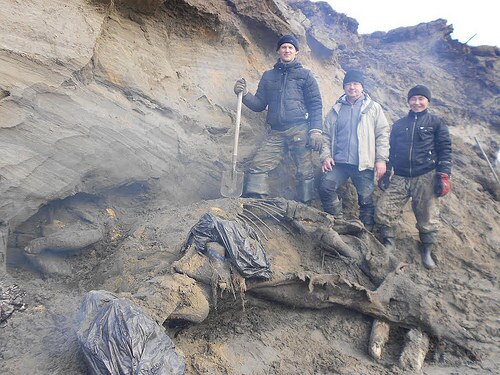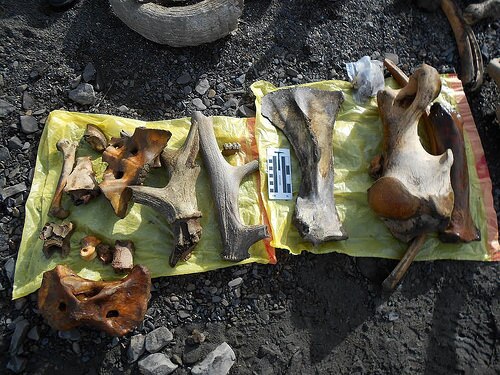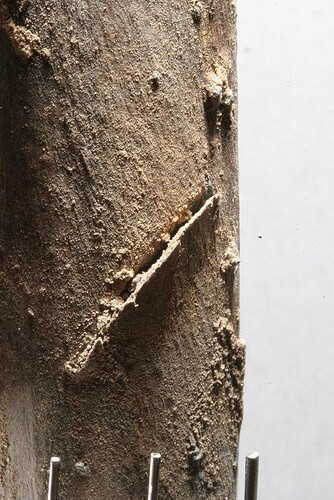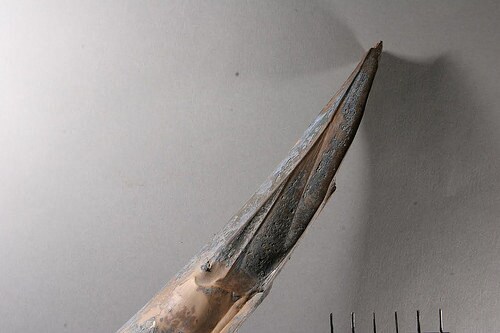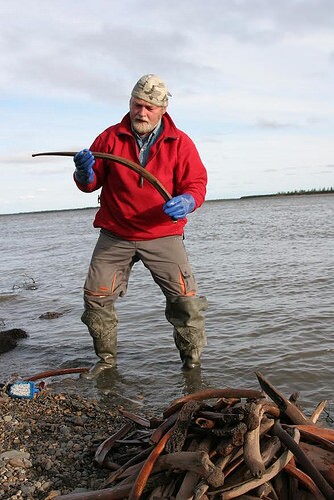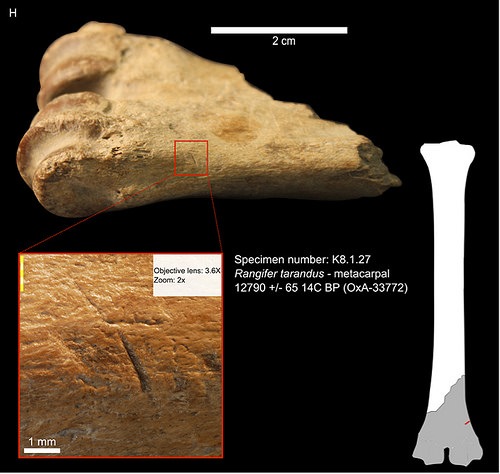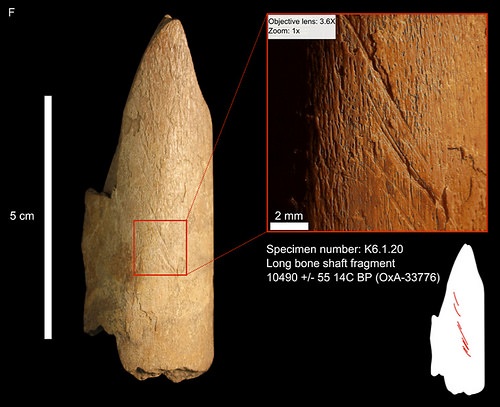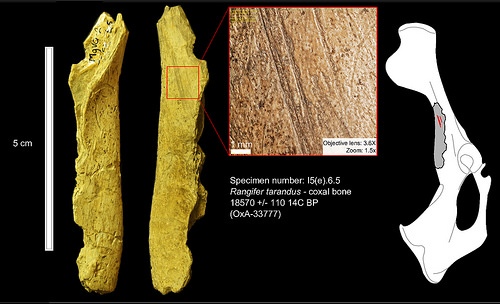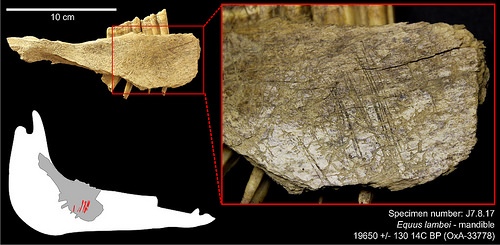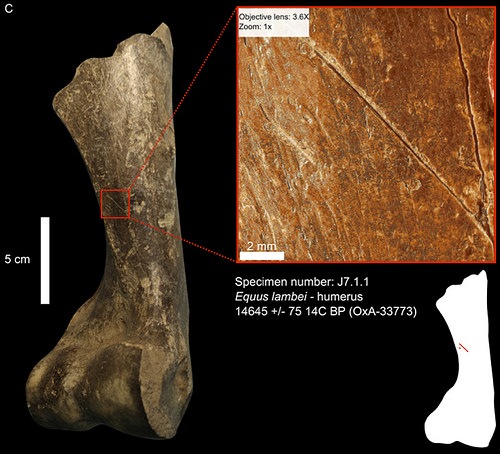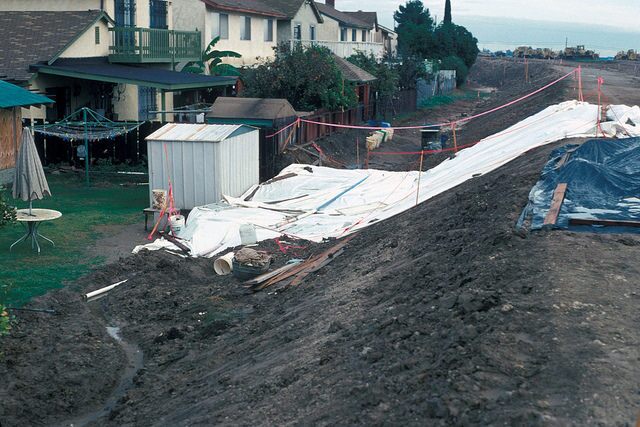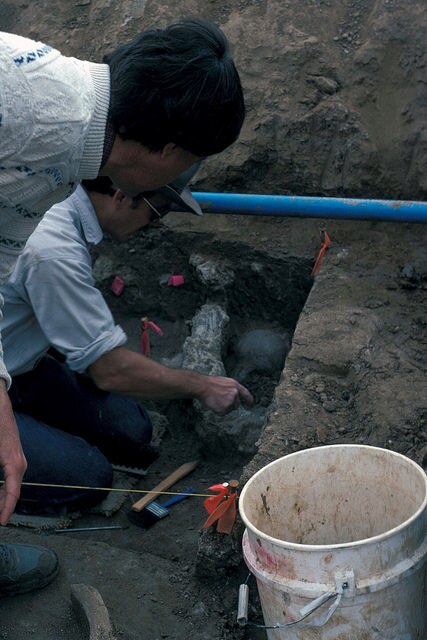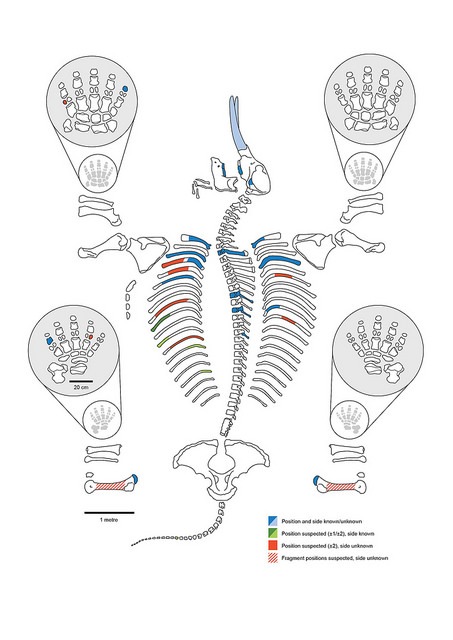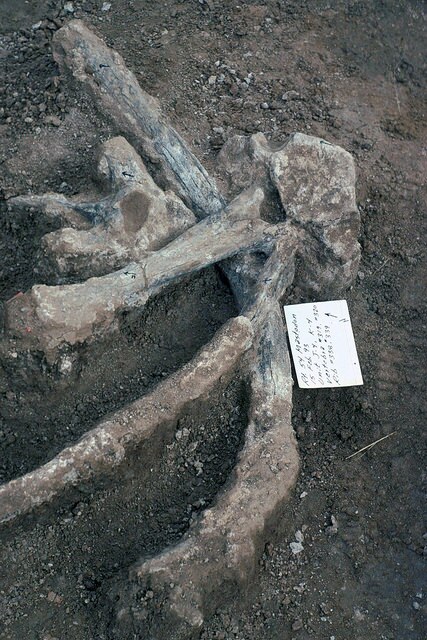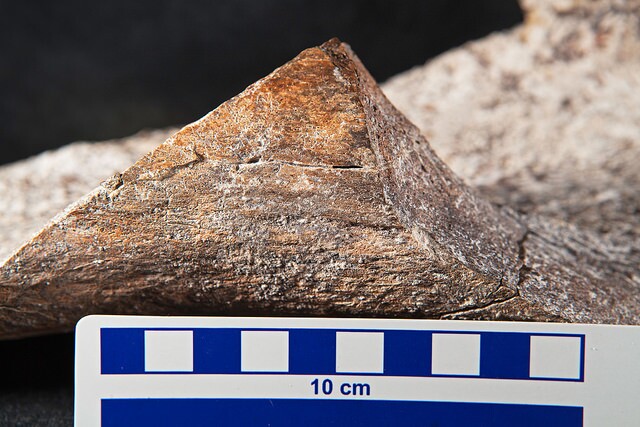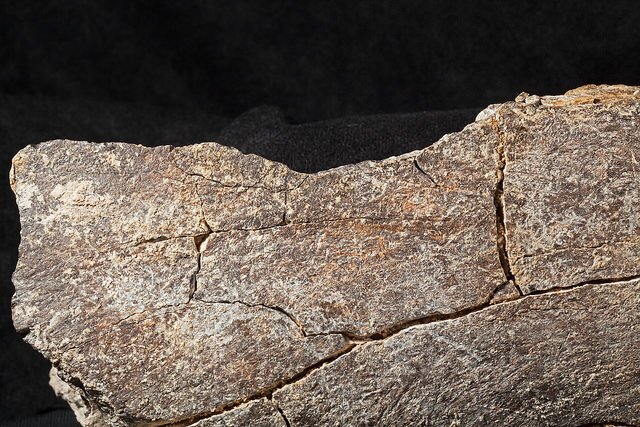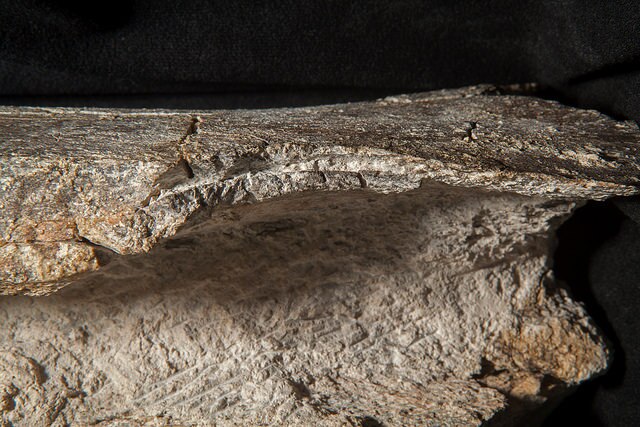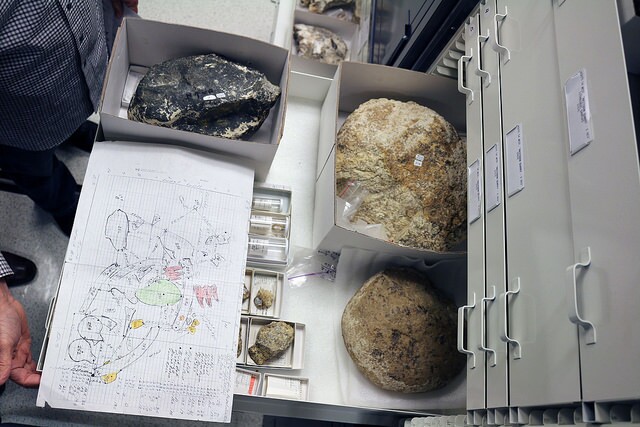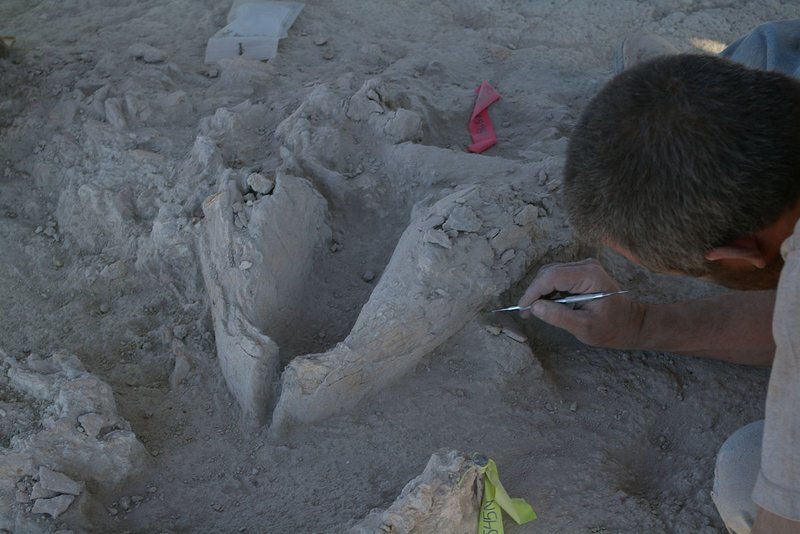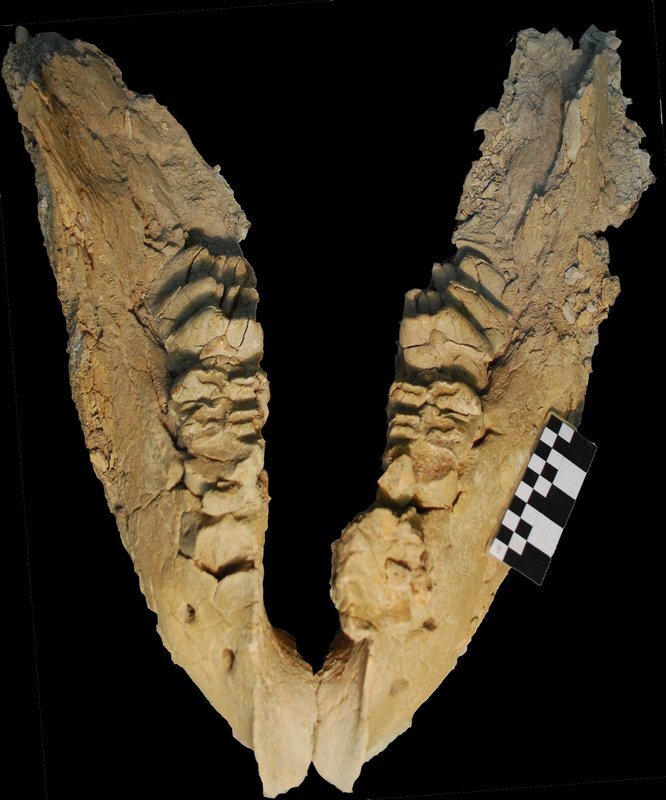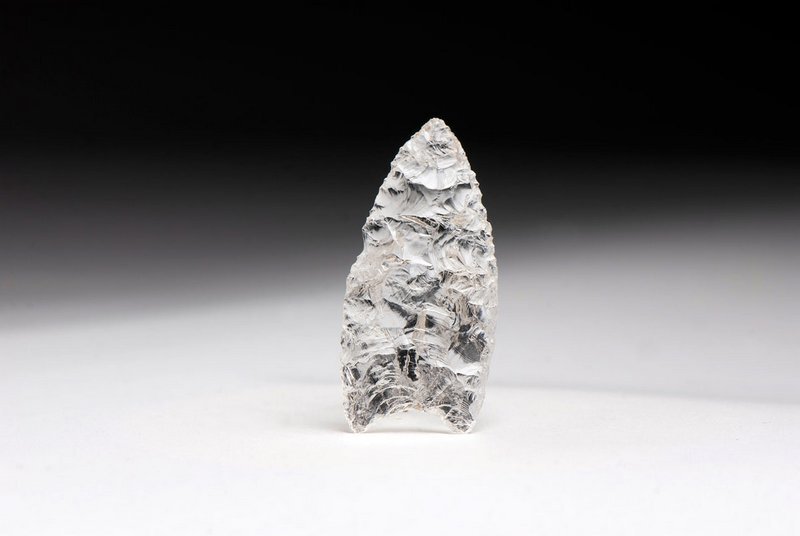
In addition to the artifacts, fossils and skeletal remains have provided scientists with valuable evidence for human activity in the Americas during the late Pleistocene. Continuing the anthology, the following articles tell the story of discoveries, some still controversial, made primarily through the excavation and examination of ancient bones. The first article takes us tens of thousands of years before humans began their journey into the Western Hemisphere, with possible implications about humans who lived within what many scientists suggest were early American ancestral Siberian and East Asian homelands:
_____________________________
Pushing the Prehistoric Fringe
By Jason Weaver
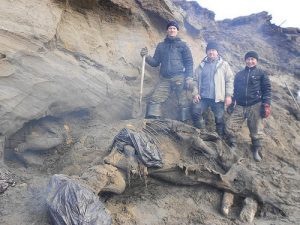
_____________________________
For some, July and August in Siberia’s otherwise frigid Taimyr Peninsula could afford tolerable temperatures for walking about. At least that was the case for 11-year-old young explorer Yevgeny Salinder. During the summer of 2012, Yevgeny was living with his parents at the Sopkarga polar meteorological station on the Sopochnaya Karga (SK) Cape, where they were working. About 2,200 miles northeast of Moscow, the Cape is a stark sub-polar alpine landscape with mossy bogs, a moist tundra with waterlogged soils, and a home for the likes of animals like reindeer, wolves, arctic foxes, wolverines and mountain hare. For most of humanity, exploring this area might be at once both severe and exotic. For Yevgeny, however, a day’s adventure hiking about the Cape would not have been extraordinary.
Until he found a dead mammoth along the way.
Preserved for tens of thousands of years where it fell to its death in the permafrost, at least some of its remains were exposed enough by 2012 to have been visible to young Yevgeny on a coastal bluff off the eastern shore of Yenisei Bay—limbs sticking out of the frozen mud where a river enters the Yenisei Bay just 3 kilometers away from his station home.
It was like finding buried treasure.
After his return, he told his parents who, recognizing the potential rarity and import of the discovery, brought it to the attention of those who would know something about such things—like Alexei Tikhonov of the Russian Academy of Sciences in St. Petersburg. Tikhonov is a zoologist by education, but he is perhaps best known for his recent discoveries and published research related to paleontological finds through various excavations at arctic and subarctic locations. Leading a small team in late September of 2012, Tikhonov carefully excavated the carcass from its natural grave. In the process, more of its features became apparent—a nearly complete mammoth, with the right half of the carcass still retaining soft tissue, including skin, hair, one ear and even male reproductive organs. Weighing in at more than 500 kg, it turned out to be among the best-preserved mammoths ever found. The excavated remains were sent for cold storage in nearby Dudinks and then shipped to St Petersburg in early May of 2013.
A Pleistocene Hunting Scene
The most tantalizing findings, however, did not occur until after the scientists dated the bones and began examining them up close. Now popularly nick-named ‘Zhenya’ after the boy founder, researchers determined that the SK mammoth was about 15 or 16 years old when he died at least 45,000 years ago, based on radiocarbon dating. The likely cause of death—human hunting.
This was revelatory, as up until now no humans were known to have existed in the Arctic this long ago. “The [new Yenisei Bay] site is much older than everything known before in the arctic regions, and it is clearly located farther north from the areas where sites of that age have been found,” said Vladimir Pitulko, also of the Russian Academy of Sciences, who examined the remains in detail. “It is about 20 degrees north (about 1900 km, or 1300 miles) of any site of comparable age…… and this is a big change.”
So how did Pitulko and his colleagues come to suggest that Zhenya met his fate by human hunters?
After closely examining Zhenya’s bones, including the left scapula, several ribs, jugal bone, and right tusk, Pitulko could come to no other conclusion than that they bore marks characteristic of wounds inflicted by a weapon and butchering marks left by stone tools. He knew this because at least one of the marks exhibited features very similar to those he found on a Pleistocene wolf humerus from excavations he conducted at Bunge-Toll in the middle Yana river in the western part of the Yana-Indighirka lowland (in westernmost Western Beringia), years before. The wolf remains had been found among the remains of other Pleistocene megafauna, such as mammoth, bison, reindeer, and rhinoceros. Using high-resolution X-ray computed tomography done by Konstantin Kuper at the Budker Institute for Nuclear Physics in Novosibirsk, Pitulko and colleagues could see a clear bone injury caused by penetration of a sharp implement with a conical tip. “The tool penetrated the bone deeply, taking pieces of cortical pieces inside the bone, which means it was a powerful blow,” said Pitulko. And now, some years later, Zhenya’s bone marks were likewise telling. “One of them was found on the inner side of the jugal bone (cheek bone) which was still attached to the skull. There is no natural or taphonomic reason for such an injury — this was not a bone pathology, it was not the result of carnivore chewing and it was not left by the excavation process — therefore we may expect it to be a result of human contact,” said Pitulko. After X-ray computer tomography conducted by Konstantin Kuper, the researchers were actually able to determine the inflicting weapon’s shape and size, enough to even reconstruct the shape of the tip that penetrated the bone. “It had a thinned symmetric outline and was relatively sharp,” continued Pitulko. “In most cases, bone or ivory weapons have a conical tip that is symmetric and quite acute (~30° to 40°) at the end, but they are [usually] relatively fragile and often break as they penetrate bones. In this case, the tool resisted breaking and inflicted injury on the cranial bones. The blade retained its weapon characteristics and retained enough energy to penetrate the cheekbone surface deeply into the bone. The blow was evidently very powerful and was suffered by the animal from the left back and from top down, which is only possible if the animal was lying down on the ground.” Pitulko suggests that the blow was likely an attempt intended for the base of Zhenya’s trunk, a hunting practice still used by elephant hunters today to cut major arteries and cause mortal bleeding. “This blow becomes necessary,” he maintains, “after the animal has been sufficiently injured, and the SK mammoth (Zhenya) displays numerous injuries in the thoracic area (the ribs and the left scapula). The most remarkable of them is found on the fifth left rib. This is an incision or cut mark left by some sharp tool slicing down. This pattern is very typical on mammoth bones, specifically on ribs, found [for example] at the Yana site.”
Overall, Tikhonov, Pitulko and colleagues suggest a scene where Zhenya was encountered by human hunters about 45,000 years ago, wounded/ brought down and killed, and then butchered immediately thereafter in place. Cut marks clearly made by cutting tools were evidenced on the left scapula and ribs, and even the right tusk showed signs of bone removal of a nature that suggested the possibility that the hunters fashioned ivory cutting tools from Zhenya himself.
________________________________________________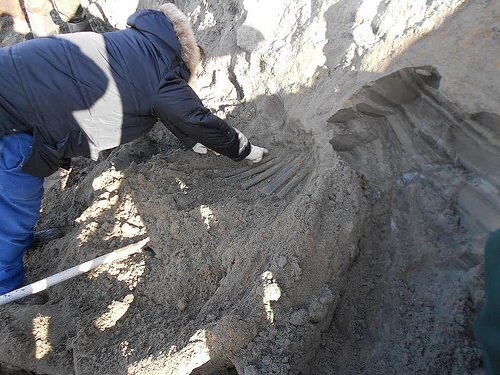
Excavations of the SK mammoth site in late September of 2012 near Sopochnaya Karga weather station at the Yenisei river mouth. Photo by Aleksei Tikhonov
________________________________
SK mammoth (‘Zhenya’) unearthed. Sergey Gorbunov is excavating the left side of the carcass in the head area. Photo by Aleksei Tikhonov
_________________________________
The SK mammoth (‘Zhenya’). Aleksei Tikhonov (in the middle, and his field crew). Photo by S.V.Gorbunov
___________________________________________
Selection of bones collected by Tikhonov at the Bunge-Toll site. Note the wolf humerus (top left) positioned by the injuried side up. Photo Aleksei Tikhonov
_________________________________________

Aleksei Tikhonov (left) and Vladimir Pitulko discussing injury on the jugal bone of the SK mammoth at Zoological Museum (RAS), St Petersburg. Photo by Elena Pavlova
_______________________________________
Cut mark on the SK mammoth 5th left rib. Photo Pavel Ivanov
_________________________________________
Documenting human caused injuries on the SK mammoth scapula at the Institute for the History of Material Culture, RAS, St Petersburg. Pavel Ivanov and Vladimir Pitulko (on the right). Photo by Elena Pavlova
__________________________________________
The Significance and Implications
Paleolithic records of humans in the Eurasian Arctic are relatively scarce. Only a few sites in this region have yielded clues to an early human presence. In mainland arctic Siberia, the site of Berelekh, discovered by Nikolay Vereschagin in the early 70s, was for years the location yielding the oldest evidence for human migration into the arctic regions. It dated to about 13,000 years ago. But in 2001 another site in Siberia, known as Yana, produced evidence of a human presence dating back to about 27,000 -30,000 years. Excavated by archaeologist Vladimir Pitulko, also of the Russian Academy of Sciences, it yielded tools made from rhinoceros horn and mammoth tusk, as well as hundreds of other stone artifacts including choppers, scrapers and other biface implements. “But I never thought that even this was the final age estimate for human migrations into the arctic,” said Pitulko.
So Zhenya and the SK site have buttressed the site researchers’ suggestion that people were present in the central Siberian Arctic by about 45,000 years ago. At this time, according to Pitulko, mammoth hunting by modern humans probably became a critical element in human survival in the harsh environment and landscape of what is today Siberia. Like the modern-day elephant, the mammoth would have provided a critical source of food, fuel (dung, fat, and bones), and raw material for construction and hunting weapons and tools for processing, all the more important in the open landscapes of the Northern Eurasian steppe, which is mostly tree-less. Removed from the hunted dead carcasses of their mammoth prey, “ivory became a substitution for materials used for shafts and points long and strong enough for killing large animals, not necessarily the mammoth,” said Pitulko. “Such tools are found elsewhere in the Upper Paleolithic, and this includes even full-size spears of ivory which are known from [the sites of] Sunghir, European Russia or from Berelekh, Siberia. This innovation became a really important discovery for humans and finally helped them in surviving and settling these landscapes.”
_________________________________________
Worked tip of the SK mammoth tusk. Photo by Pavel Ivanov
____________________________________________
Field study of the bones collected at the Yana site from the Yana mass accumulation of mammoth (August 2012) – looking for human impact. Photo Elena Pavlova
_________________________________
Pitulko surveying exposures in Yana river. Photo Elena Pavlova
__________________________________
Thus, according to the researchers’ report, advancements in mammoth hunting likely allowed humans to survive and spread widely across northernmost Arctic Siberia at this time, representing an important cultural shift – one that likely facilitated the arrival of humans in the area close to the Bering land bridge, providing them an opportunity to enter the New World before the Last Glacial Maximum.
“This is especially important for questions related to the peopling of the New World, because now we know that the eastern Siberia up to its arctic limits was populated starting at roughly 50,000 years ago,” says Pitulko. “Until 15,000 years ago, sea-level (though changing) still remained low, which is clear from appropriate dates on terrestrial animals in the New Siberian islands. This presumes that the Bering Land Bridge existed probably most or part of this time, so the New World gate remained open…….The history of the territory which we call Western Beringia is of particular interest since it is close to the Bering Land Bridge area and then everything that was going on in this area is related (or can be related) to the question of the peopling of the New World. Most of the Eurasian north, including Western Beringia, was unglaciated [at this time] and available for humans.”
Could modern humans have crossed over to the New World from here in these early times?
“Probably yes,” says Pitulko.
But did they?
Pitulko recognizes that there is much more work to do, and additional finds that need to be made, before this question can be answered and a conclusive picture of human habitation in these regions can be drawn. In any case, for now, a new stage is set for going forward.
“These finds change our minds about possible options and this is going to provide a new stimulus for further research.”
_______________________________
Bluefish Caves: The Oldest Known First Americans?
By Jesse Holth

____________________________
In 1977, Canadian archaeologist Jacques Cinq-Mars spent 10 years leading the excavation of a uniquely important site known as Bluefish Caves in Yukon, Canada. What he and his team discovered there eventually became what is today one of the most compelling, albeit controversial, chapters in the ongoing search for the first Americans………..
Cut-Marks in the Bones
The Bluefish Caves site consists of three karst (limestone) caves, located about 50 kilometers away from Old Crow village in northern Yukon. The Caves – like the HMS Terror site in Nunavut, and so many others – were already known to local First Nations members in the area. “The Vuntut Gwitchin [people] knew about the caves and visited the site many times,” says Lauriane Bourgeon, a researcher who has been studying ancient remains recovered from the caves. But it was the Cinq-Mars expedition that conducted the first archaeologically controlled investigation of the site, leading to the recovery of a wealth of faunal remains, including fish, birds, and mammals, as well as around 100 lithic artifacts, including microblades, cores, burins, small flakes, and other debris. When Cinq-Mars and his team radiocarbon dated the artifacts, the results were shocking: they appeared to be close to 25,000 years old.
This new evidence challenged the widely held theory that humans didn’t arrive in North America until much later. Not surprisingly, Cinq-Mars’ work was largely dismissed by much of the scientific community. That is, until decades later, when Université de Montréal’s Ariane Burke and Lauriane Bourgeon of the Hominin Dispersals Research Group (HDRG), and Dr. Thomas Higham, Deputy Director of Oxford University’s Radiocarbon Accelerator Unit, returned to study the faunal collections, now housed at the Canadian Museum of History.
One of their objectives was to re-determine radiocarbon dates for human activity at Bluefish Caves. The first step was to establish which bones were culturally modified, and which bones were marked as a result of natural processes. Since striations and breakages can be produced by rock abrasion, archaeologists must carefully and systematically identify cut-marks made by humans – and separate them from markings that merely seem like human activity, but can be explained by other events.
Misleading cut-marks are often produced by carnivores, for example, whose jaws can create bone breakage and flaking that resemble human attempts at marrow extraction. One way to tell these markings apart is by the presence of other pits and punctures scoring the surface, created by carnivore activity. The bones may also be accompanied by bits of digested bone, left behind from the carnivores that consumed it. One of the most distinctive features of carnivore activity is the U-shaped tooth marks they tend to score into the bones.
Researchers evaluated and recorded such tooth marks for every specimen – with carnivore activity as an alternate explanation, these markings could not be used as evidence for definitive human activity. Bones that appeared to have been damaged by weathering, as well as biological agents like rodent gnawing, were also removed from the group of potential human cut-marks. While it’s possible these other processes may have simply obscured relevant cultural modification, scientific inquiry mandates a greater degree of certainty in the data. Therefore, the researchers used a set of six criteria for each potential cut mark, to determine which ones could have been the result of human butchery.
Searching for evidence of human modification can often be like finding a needle in a haystack. In this case, a whopping 36,000 mammal bones were examined from the caves designated as Bluefish Caves I and II. While researchers determined that the vast majority of samples were the result of carnivore activity – wolves, lions, and foxes were among those responsible for the bone accumulation – both caves also contained human-modified bones. The team postulated that Canids used the caves for den sites in the spring and summer, and that human occupation at the caves was sporadic and brief.
Biological and natural geological processes can present an obstacle when identifying cut-marks. Of the specimens from Cave II, for example, root etching was discovered on over 70% of the bones. Root etching is caused by the excretion of humic acid from plant roots, which leaves dendritic grooves in the surface of the bone. In Cave I, the more significant problem was abrasion – this had caused damage to 57% of the bones.
Ultimately, the researchers were able to determine that fifteen samples were definitively modified by humans, and twenty more were considered “probable” examples of cultural modification. The activities documented by the cut-marks on the bones included skinning, dismembering, and defleshing. The species represented in the human-modified samples included horse, caribou, wapiti (elk), and possibly Dall sheep and bison, as well as a bird scapula.
Six of the cut-marked bone samples were selected for radiocarbon dating, and the results yielded dates ranging from 24,000 to 12,000 cal BP. The oldest specimen was a cut-marked horse mandible from Cave II – this evidence, along with a caribou pelvis (also from Cave II) confirms a human presence dating to 24,000 – 22,000 cal BP. The caribou bone showed signs of filleting, while markings on the horse mandible were consistent with the removal of the tongue. Previous analysis on one of the horse’s teeth had also showed that it was killed in spring or summer, indicating a human presence during the warmer seasons. These findings are significant because they suggest that humans were, at least sporadically, living in North America during the Last Glacial Maximum (or LGM) and not after, as previously thought.
The human presence at Bluefish Caves also spans over 10,000 years – the caves were used on several occasions (or more) during the frigid cold of the LGM (then the Pleistocene) and into the Holocene. Three bone specimens from Cave I were dated to between 22,000 and 15,000 cal BP: a horse humerus, a horse metatarsal, and a caribou metacarpal. The humerus and metacarpal show marks from filleting activity, and the metatarsal shows signs consistent with the stripping of tendons. The youngest specimen, dating to 12,000 cal BP, was an unidentified bone fragment with signs of filleting. While the species couldn’t be confidently identified, researchers suggested it could be a wapiti bone, since other cut-marked wapiti bones were discovered in the same cavity.
While root etching, scavenging, and other biological and natural processes likely destroyed much evidence of human activity, we nevertheless now have definitive proof of human occupation at Bluefish Caves. The absence of hearth features and other markers suggest that the caves were used seasonally, probably as short-term hunting sites. This is the case for several Beringian cave sites, including Alaskan examples like Lime Hills Cave, Lower Rampart Cave 1, and Trail Creek Caves. By dating the cut-marked bone specimens from Bluefish Caves, HDRG researchers have provided archaeological support for what is known as the “Beringian standstill hypothesis.”
___________________________________________
Horse metatarsal from Cave I: Cut-marks from stone tools indicate possible tendon stripping. Image courtesy Lauriane Bourgeon, Ariane Burke, and Thomas Higham
_________________________________________________________
Caribou metacarpal from Cave I: Cut-marks from stone tools indicate filleting. Image courtesy Lauriane Bourgeon, Ariane Burke, and Thomas Higham
____________________________________________________________
Unknown long bone fragment from Cave I: Possibly Wapiti bone, cut-marks indicate filleting. Image courtesy Lauriane Bourgeon, Ariane Burke, and Thomas Higham
____________________________________________________________
Caribou coaxal bone from Cave II: Cut-marks indicate filleting activity. Image courtesy Lauriane Bourgeon, Ariane Burke, and Thomas Higham
_________________________________________________________
Horse mandible from Cave II: Cut-marks indicate removal of tongue with stone tool. Image courtesy Lauriane Bourgeon, Ariane Burke, and Thomas Higham
__________________________________________________________
Horse humerus from Cave I: Cut-marks from stone tools indicate filleting. Image courtesy Lauriane Bourgeon, Ariane Burke, and Thomas Higham
_________________________________________________________
The Standstill and the Earliest Americans
The standstill hypothesis proposed that a genetically isolated human population existed in Beringia, from at least 23,000 to 15,000 cal BP, before eventually spreading into North and South America after the LGM. While human activity had already been documented in Western Beringia, from Yana River sites dating to 32,000 cal BP, there was little evidence to support the theory from Eastern Beringia. That is, until Bluefish Caves, which now verifiably indicate that people were in Eastern Beringia by at least 24,000 cal BP, during the LGM.
According to the theory, Central Beringia would have been the primary habitation zone for a human population until it was submerged at the end of the Pleistocene. Even during the LGM, Central Beringia would have been habitable – with warmer, humid conditions and even occasional shrubs and trees, humans would have had access to both fuel and food. Rising sea levels would eventually push the population inland; unfortunately, this also means any evidence of human habitation in Central Beringia is likely destroyed, degraded, or still underwater.
It’s possible that Bluefish Caves was located at the eastern border of this population’s range. Seasonal hunting parties, venturing out of the core range and into the steppes of Eastern Beringia, would explain intermittent visits to sites like Bluefish Caves. This matches the data recovered, which indicates irregular human occupation over a long period of time. Researchers have proposed that the standstill population was fairly small – tens of thousands at the most – based on both archaeological and genetic evidence. After the LGM, as the climate improved, it’s believed that the population increased and caused new expansions into North America. Humans were still using Bluefish Caves, as documented by the cut-marked bones, but became reliant on different species (such as caribou, bison, and wapiti) since others, like the horse, had become extinct by about 14,000 cal BP.
Around this same time, the warming climate allowed an ice-free corridor to form between the Laurentide and Cordilleran ice sheets. Long since believed to be the route that humans took to migrate from Beringia down into North America, the corridor wouldn’t have been suitable for human travel until 13,000 or 12,500 cal BP. Many archaeologists now suggest that these early inhabitants of Beringia likely travelled down the Pacific coast instead, as early as 16,000 cal BP. Archaeological evidence supports this theory, showing that humans settled south of the ice sheets before the ice-free corridor formed.
Bluefish Caves is not only the oldest known human habitation site in North America – it was also used sporadically for over 10,000 years, and provides evidence of a potential “standstill” population in Beringia during the LGM. It appears that humans survived and subsisted off the land bridge for an extended period of time, creating a genetically distinct population, and only began to migrate when sea levels started rising. As the climate warmed up, more people were able to survive, creating a strain on resources and causing expansion into North America. It’s possible the standstill population travelled along a coastal route, leaving evidence south of the ice sheets. Or, some other seafaring group or groups may have travelled there first – leaving evidence at sites like Buttermilk Creek Complex in Texas and Monte Verde in Chile – and the standstill population followed the ice-free route later. Burke confirms there is “much speculation about possible coastal dispersals,” noting that “the discovery of very early Clovis sites in North America… occur too close to the presumed opening of the ice-sheets to explain their geographical distribution.” According to Burke, “more survey work will be necessary – both in Canada and in eastern Siberia – in order to find more material to support the standstill hypothesis.” Although the theory doesn’t directly address subsequent migration routes, if it can be further substantiated we will be one step closer to determining the settlement patterns of North America’s first humans.
_________________________________________
The Extraordinary Case of the San Diego Mastodon
by James Kensington
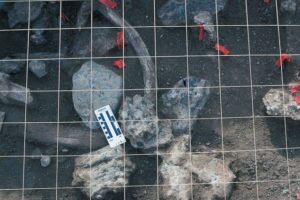
______________________________
When news of the published study report in the prestigious scientific journal Nature broke, it became a bombshell headline for science media reporters. “Humans in California 130,000 years ago? Get the Facts,” flashed one widely read headline by National Geographic — “A 130,000-year-old archaeological site in southern California, USA,” reported the study abstract from Nature — “Ancient humans may have reached Americas 100,000 years earlier than thought,” posted USA Today. These were but a fraction of the published stories.
To be certain, the authors of the report, including Thomas Deméré, Steven Holen, Kathleen Holen, and other scholars and scientists, knew this would be grist for scholarly skepticism and criticism for years to come. They were braced for it. But the evidence, to them, after years of study, was compelling enough to move forward with their results in a public way. They knew the implication of their study was enormous — humans, or human-like creatures — hominins — were on this continent, at least in the present-day San Diego area, well more than 100,000 years earlier than the earliest generally accepted dates for the first peopling of the Americas, currently established at around 14-15,000 years ago, or based on the recent Bluefish Caves discoveries, possibly at least 24,000 years ago. A very exciting discovery, if one could ignore a legion of scholars shaking their heads in skepticism.
The Discovery
The story began in November 1992, when workers under a California Department of Transportation (Caltrans) highway construction project exposed something curious while excavating with a backhoe on State Route (SR) 54, where San Diego borders National City. As State law requires, paleontologists from the San Diego Natural History Museum’s PaleoServices Department were on site doing routine monitoring of the grading activities, in case any fossil material might be encountered. It wasn’t long before the paleontologists justified their presence, and in a very exciting way. As field paleontologist Richard Cerutti watched the caterpillar backhoe excavate through the sandy soil, he spotted what appeared to him to be a horizontally oriented mammoth tusk bone. Construction work in the vicinity of the finds was immediately halted, and the nature of the excavation changed from one using heavy construction and excavation equipment to one using much finer methods — methods typically used by paleontologists and archaeologists. Excavations continued on and off over a period of five months, and together with the San Diego Natural History Museum’s PaleoServices Director Dr. Tom Deméré and a team of site investigators, the team encountered more fragments, including molars, clearly revealing that what they were looking at were actually the remains of a mastodon, a large mammal that inhabited the region during the Pleistocene, becoming extinct about 10,000 -13,000 years ago.
But there was something else that was tantalizingly peculiar about these remains. As they continued to excavate, they could see that many of the bones were fractured or broken in a way that was not typical of bones broken by the forces of the natural environment. Said Kathleen Holen, Director for the Center for American Paleolithic Research in Hot Springs, South Dakota, and one of the authors of the study: “The fragments were found to be clustered in two distinct areas around rocks. The heavy limb bones, which are useful for making tools, were smashed and broken up, but the lighter bones like ribs and vertebra were more complete. We found characteristic marks on the bone surfaces, notches and scars where flakes of bone had been removed, and this is characteristic of bone that has been broken by percussion, that is, with hammerstones. We also found cone flakes that occur characteristically around the point of impact, much like when you see a B-B strike a window — those circular patterns break off in flakes. In our experience, these bones were broken in patterns usually associated with human modification, broken while they were still fresh.”*
Added to this was the discovery of several large stones found within the same sediment layer as the bones. Finding large stones was not unusual. But finding them located precisely where the modified bone fragments were located was peculiar. “We found stones that were located right within the concentrations [two separate clusters] of the mastodon bone fragments and flakes and the stones and bone fragments could be refit back together so it showed that whatever happened, it was all in the same location,” continued Holen who, along with her husband scholar and study co-author Steven Holen, joined the team efforts in 2008. “We found marks on the rocks that were characteristic of them being used as pounding tools. So there was pounding evidence on both the rocks and on the mastodon bones. Then we saw other signs of human behavior — for example, the location of one of the impacts indicated that there was cooperation between at least two people to steady this bone on an anvil and then break it.”*
The team considered the possibility that this was all a result of natural processes. But the Holens and colleagues could not fit what they saw into scenarios based on natural causes. “We found no evidence that carnivores have interacted with the bones or that there had been a trampling event that broke the bones and there is no evidence of flooding that would have caused the rocks to break the bones because the flooding would have washed away these smaller fragments that were still right with the stones.”
They knew this would not be enough to draw any conclusions, so to confirm or deny their hunch, they turned to additional expertise. One of these experts was Dr. Dan Fisher, a paleontologist from the University of Michigan — an expert on mastodon fossils. Fisher had significant experience excavating mastodon and mammoth sites that exhibited bones broken while they were still fresh. Carefully examining the site and the evidence, he concluded that there were clear signs that the bones had been broken by percussion.
The logical question followed: Were the stones within the clusters really used as tools by humans to break the bones? To answer this question, in 2015 they sent the stones to a well-recognized expert on use-wear analysis, Dr. Richard Fullagar, an archaeologist at the University of Wollongong in New South Wales, Australia. Fullagar examined the stones and compared them to known stone tools, as well as other stones used by the research team to break open fresh elephant bones as an experiment. His conclusion: The stones showed the same abrasions, fractures, and marks that could only come from repetitive impact. To help with further study of the samples, they employed Dr. Adam Rountrey, a colleague of Fisher’s, to produce 3D digital models.
The researchers were unanimous. This looked like an archaeological site — a site, no longer occupied by human or animal, with evidence of past human activity.
But what about that other critical question — the age of the site?
Once they had solid samples to be sent for dating, the team did not waste any time. They were sent to USC geologist Dr. Richard Ku for analysis using the radiometric (U-Th) dating techniques of the time (1992/1993). On December 29, 1993, Ku called Deméré with some startling news — a caliche (sedimentary rock) sample from the Cerutti mastodon sediment layer yielded a date of about 190,000 ka. Deméré nearly fell out of his chair. In January, 1994, Ku sent the formal letter report of the dating results. But the Cerutti mastodon site, as far as the mainstream scholars were concerned, joined the plethora of American Paleoindian sites considered as questionable in terms of age. It wasn’t until almost two decades later when they again sent samples for dating, this time to Dr. James Paces, geologist and geochronologist at the U.S. Geological Survey. From 2012 to 2015, Paces applied more advanced and reliable Uranium radiometric dating analyses on “prepared multiple specimens, performing digestions, chemical separations and purifications, and complete isotope analyses on nearly 100 individual subsamples”.** The result: The mastodon bones and associated stones were buried in sediments that are about 130,000 years old, give or take 9,400 years.
With this, the research team was ready to go public again, and in 2016 they submitted their report to Nature for review. The report was published in 2017, and the news broke in major venues across the world — humans may have been in the Americas more than a whopping 100,000 years before the earliest known dates for the first peopling of the continents.
Deméré, the Holens, and the rest of the research group anticipated that this would ignite controversy. And sure enough, it generated a firestorm of criticism across a broad spectrum of the scholarly community, especially among scientists involved in First Americans research.
______________________________________
San Diego Natural History Museum paleontologist Richard Cerutti (after whom the site was named) observing an excavator expanding the Cerutti Mastodon site, March 1993. Courtesy San Diego Natural History Museum.
______________________________________
View looking east of the Cerutti Mastodon site, November 1992. Courtesy San Diego Natural History Museum.
___________________________________
Caltrans archaeologists Karen Crafts, Chris White, and Don Laylander excavating fossils found at the Cerutti Mastodon site, November 18, 1992. Courtesy San Diego Natural History Museum.
___________________________________
Brett Agenbroad (top left), Larry Agenbroad (left), James Mead (bottom left), and Dr. Tom Deméré excavating fossils found at the Cerutti Mastodon site, December 29, 1992. Courtesy San Diego Natural History Museum.
__________________________________
Vertebrate paleontologist Dr. James Meade and Director of PaleoServices Dr. Tom Deméré observing an exposed rib and femur ball in the upper right corner of excavation unit D-3 at the Cerutti Mastodon site. Courtesy San Diego Natural History Museum.
___________________________________________________
Mastodon skeleton schematic showing which bones and teeth of the animal were found at the site. Courtesy San Diego Natural History Museum.
___________________________________________________
The Archaeological Site That Can’t Be
Clearly, the Cerutti Mastodon (CM) site findings up-ended the emerging concept on the timing of the first peopling of the Americas in a major way, and the big names in research on the subject were not going to let this go unchallenged. But the dating itself was actually not the biggest problem for the critics. The process and techniques used on the CM site dating are broadly considered to be the most reliable and accurate that could have been done to date. “Basically we have to believe the date,” says Warren Sharp, an expert on radiometric dating. “The date is not the question in this study. There have been lots of people that have claimed that they had some kind of archaeological evidence for people earlier than 15,000 years ago or so. But if this really passes muster, then I think all of those sites and all of those claims are going to be looked at with new eyes and people are going to not just dismiss them out of hand.”*
So with the age set aside as a point of contention, the real problem lies in the interpretation of the site as an archaeological site — a location that bears evidence of human occupation or activity. The most salient critiques have revolved around a widely held principle: that extraordinary conclusions or findings require an extraordinary preponderance of credible evidence. They have to meet several crucial tests, namely, that “(1) Archaeological evidence is found in a defined and undisturbed geologic context; (2) Age is determined by reliable radiometric dating; (3) Multiple lines of evidence from interdisciplinary studies provide consistent results; and (4) Unquestionable artifacts are found in primary context”.***
One of the biggest points of contention centers on the suggestion that the ‘hammerstones’ and ‘anvils’ are indeed artifacts, the fourth test as noted above. “To demonstrate such early occupation of the Americas requires the presence of unequivocal stone artifacts,” says Michael R. Waters. Waters is a prominent scholar on the archaeology of early Americans and has held the Endowed Chair in First American Studies at Texas A&M University, the directorship of the Center for the Study of the First Americans, and serves as the Executive Director of the North Star Archaeological Research Program. Waters has been at the forefront of research with his discoveries of evidence of early American occupation as much as 14,000 – 15,000 years ago at such locations as the Debra L. Friedkin site in Texas and the Page-Ladson site in Florida. Regarding the Cerutti Mastodon site, however, he asserts “there are no unequivocal stone tools associated with the bones.” The stones described at the Cerutti mastodon site simply don’t meet the stringent standards required to be designated as artifacts, he maintains.
Tom Dillehay, the renowned anthropologist with Vanderbilt University who was key to the claimed discovery of a 14,500-year-old human presence at Monte Verde, Chile, agrees. He says that the Cerutti site study does not fully rule out the possibility that the stones were moved to the site by natural processes, and that the wear patterns on the stones may have been the result of the stones bumping against other stones in a moving stream.
“Holen has made similar claims for other sites he has worked on in the Midwest,” says James M. Adovasio, the archaeologist who led the famed excavations of the Meadowcroft rock shelter in Pennsylvania, where evidence of human activity dated to at least 16,000 years ago was discovered. “These sites have also been roundly critiqued because he has not effectively ruled out other means by which the bones may have accumulated. This is perhaps the biggest problem with all such sites. Specifically, is there a natural, non-anthropogenic, possible explanation for the bone accumulations and their patterning? In the case of Cerutti and the Midwestern localities, this question has not been answered.”
Another argument against the Cerutti site raises the problem of a clear absence (thus far) of bifacial stone tools, a technology that was well-established by 130,000 years ago and would likely have been transported to the New World by its original prehistoric Old World settlers coming from the west. “Though bifacial technology is well developed at this time in the Old World, there is not a shred of it at Cerutti,” says Adovasio. “It is obviously not absolutely necessary that bifacial technology be present on such a site,” he adds, but “all of the bona fide Old World sites of this time period exhibit such materials”.
And then there are the bones. Skeptics are not convinced that the large bones, including teeth, were broken by humans using the ‘hammerstones’ and ‘anvils’, as the study suggested. “If, as the authors claim, they are splitting bone for marrow and/or tool production,” says Adovasio, “why are all of the pieces from these processes still there? They all retrofit. Additionally, no one splits teeth for marrow!”
Another voice of caution has been expressed by Briana Pobiner, a paleoanthropologist at the Smithsonian Institution and a noted expert on recognizing human activity through the examination of bones.
“What concerns me most about the CM site is a lack of any butchery marks on the mastodon fossils – and the lack of stone tools,” she says. “Interestingly, at ethnographic and some archaeological proboscidean (elephants and their extinct relatives) butchery sites you sometimes don’t see any butchery marks because these animals are so big that you can easily cut meat off of them without leaving any butchery marks — but that’s when the goal is meat processing. To break open the bones for marrow, you need to strip all the meat away, including the connective tissue (like periosteum and cartilage) surrounding the bone, which can be up to 3mm thick on elephants. It seems odd not to see any evidence for that kind of processing [at this site] — nor for the tools used to do that processing.” However, she added, “perhaps the bone could still be “fresh” after the connective tissue has decayed away. In a 2015 paper, Haynes and Klimowicz noted that elephant limb bones can retain grease for up to 3 years, and retention of grease likely means spiral fracture” when attempting to break open bones for access to marrow. This contrasts with bones when they are dry and past the fresh stage, when breakage is characteristically “jagged, longitudinal, or parallel to the long axis of the bone”.
But Pobiner is not totally convinced that the Cerutti bone spiral fractures were necessarily caused by humans.
“Researchers used to always attribute spiral fracture to human activity, but a few decades ago it was demonstrated that carnivore chewing and other activity can spirally fracture bone –- it’s indicative of the timing of breakage, not the cause of breakage,” she added. “Gary Haynes, an expert on proboscidean butchery, has studied hundreds of natural elephant bone sites in southern Africa, and found that at some sites up to 62% of the limb bones are spirally fractured” by natural causes.
The Defense
The study authors, on the other hand, are confident they have a strong case for further testing and investigation.
“Only a few of them produce the full banquet of evidence that would be convincing to a really wide range of people,” says Fisher, a key participant and co-author of the study report, about sites like the Cerutti case. “I think the Cerutti site produces that full banquet in a way that very few others do. At the same time the nature of the evidence that is there is completely parallel, completely consistent with patterns that we see at other sites. So not only do I not have a problem with interpreting this as human activity, but I feel I would be intellectually dishonest to turn away from this and say, well, it can’t be human activity only because it’s too old. It’s the same as we see in the best cases where we argue for human activity.”
And while some of the best scientists around the world are itching to poke holes in those statements, the Cerutti site team points to a list of reasons why they think their case is convincing. As published for the media by the San Diego Natural History Museum, the researchers had the following to say:
Regarding the argument that the finds may have been caused by other natural or geological events:
— The pattern of the mastodon bone bed differs from that of the skeletons of horse, dire wolf, and deer discovered in other strata within the same Pleistocene rock;
— the occurrence of large and small bones together with five large cobbles within an otherwise sandy silt horizon indicates that fluvial processes did not transport the bones and rocks; and
— we studied sites where flood events left bone material redistributed. At those sites, moving water sorted the bones by density and size. This wasn’t the case at the Cerutti Mastodon Site, where everything from small molar fragments to large rocks were distributed, unsorted, around the site.
Regarding any argument that the bone breakage observed at the Cerutti site may have been caused by animal gnawing or other behaviors:
— No Pleistocene carnivore was capable of breaking a fresh mastodon femur at mid-shaft or producing the observed wide impact notch;
— The presence of attached and detached cone flakes is indicative of hammerstone percussion, not carnivoran gnawing, and there is no carnivore bone modification at the Cerutti Mastodon Site nor bone surface modification from gnawing;
— The differential preservation of fragile ribs and vertebrae rather than heavy limb bones argues against trampling (also no telltale trampling markings) and is consistent with selective breakage by humans; and
— Other skeletons of extinct mammals found in the same layer/strata were found relatively intact.
Regarding the conclusion that there is evidence of human activity at the site:
— The distribution pattern of bones – they were not distributed across the site in a homogenous fashion, but were instead concentrated in two key areas;
— [Again,] the pattern of differential breakage – more fragile bones were intact while the heaviest/strongest were broken;
— The pattern of breakage itself — spiral fractures indicated breakage of the bones when fresh. Impact notches and cone flakes indicated breakage from percussion;
— The way in which the rocks were broken — pieces of broken rock were found scattered throughout the site, in many cases far away from the rock they came from; and several pieces could be refitted, indicating how and exactly where particular stones broke;
— There were two main areas of concentrated bones and rocks;
— [What appeared to be] purposeful placement of some objects — mastodon femoral heads placed together side by side and the tusk driven vertically into lower sedimentary layers were two examples of these anomalies; and
— [Again,] the discrepancy between how the fossils were preserved compared to other Ice Age megafauna discovered at the same site – a sloth, a camel, an ancient horse, a dire wolf, and a capybara — which were the same age. These other animals were mostly the entire carcass/fully articulated skeletons; the mastodon was much more incomplete, and remaining bones were disarticulated and broken.***
Finally, Fullagar, upon examining the purported stone tools from the site, is convinced that the subject stones were actually used as tools. Without knowing the age of the site and their apparent association with the mastodon bones, Fullagar examined key sample stones as submitted by the site archaeologists for study. “Initially when we looked at them I was thinking perhaps they were some kind of plant processing or animal processing tool, for grinding up plant materials or small animals,” said Fullagar. “We’re able to look at these [stones] in low and high magnification and also check whether or not we can see marks that are distinctive of a stone on a bone or a stone on stone.” He found markings indicating stone on bone. “It turned out after I knew a bit more about the site [after examining the bones] that they were used for smashing up mastodon bones,” said Fullagar.
_______________________________________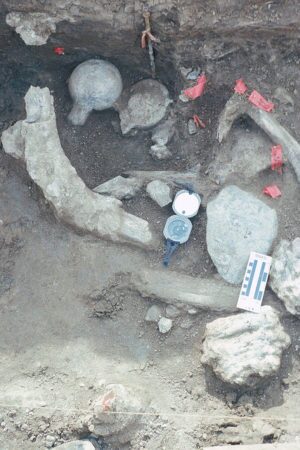
A concentration of fossil bone and rock. The unusual positions of the femur heads, one up and one down, broken in the same manner next to each other is unusual. Mastodon molars are located in the lower right hand corner next to a large rock comprised of andesite which is in contact with a broken vertebra. Upper left is a rib angled upwards resting on a granitic pegmatite rock fragment. Courtesy San Diego Natural History Museum
____________________________________
Unbroken mastodon ribs and vertebrae, including one vertebra with a large well preserved neural spine. Courtesy San Diego Natural History Museum
__________________________________________________
A view of a unit containing several fossil remains and stones. Courtesy San Diego Natural History Museum
_____________________________________________
A close-up view of a spirally fractured mastodon femur bone. Courtesy Tom Deméré, San Diego Natural History Museum
____________________________________
The surface of mastodon bone showing half impact notch on a segment of femur. Courtesy Tom Deméré, San Diego Natural History Museum
___________________________________
Side view of groove produced by percussion on a mastodon leg bone. Shows negative flake scar. Courtesy Tom Deméré, San Diego Natural History Museum
_________________________________
A boulder discovered at the Cerutti Mastodon site thought to have been used by early humans as a hammerstone. Courtesy Tom Deméré, San Diego Natural History Museum
___________________________________
One of the stones discovered at the Cerutti Mastodon site thought to be used as an anvil for bones processing. Courtesy Tom Deméré, San Diego Natural History Museum
___________________________________
 Layout depicting bone breakage experiment on a modern elephant’s leg bones in an attempt to determine the kinds of breakage patterns resulting from hammerstone percussion. Courtesy Kate Johnson, San Diego Natural History Museum
Layout depicting bone breakage experiment on a modern elephant’s leg bones in an attempt to determine the kinds of breakage patterns resulting from hammerstone percussion. Courtesy Kate Johnson, San Diego Natural History Museum
___________________________________________
What kind of human?
There were no human remains found at the site associated with the finds. But even if it could be irrefutably concluded that humans were at the site 130,000 years ago, what kind of human would we be talking about in this case? At that time in prehistory scientists know that, along with modern humans, other hominins like Homo erectus, Neanderthals, Denisovans, and possibly Homo floresiensis (the Indonesian “hobbits’) were walking the earth, and perhaps at least one other as yet unidentified early human species. However, all of these human populations are known to have existed only in the Old World. There is at this time no evidence that any species of human had journeyed beyond the Old World continents any earlier than between 20,000 – 30,000 years ago, a time when there are clues that humans may have been hanging around the ancient Beringian region (which includes present day Alaska and ancient easterly extensions of present day Siberia). And while it is possible they may have been modern humans (not archaic humans), there is no broadly accepted evidence to date that modern humans had left Africa to colonize the world by 130,000 years ago. Most estimates place them exiting Africa much later.
This leaves hominins like Homo erectus, the first generally recognized globe-trotting human species, Neanderthals (known to have existed in Western Eurasia and the Middle East and as far east as the Altai Mountains in Siberia), Denisovans (known to have existed as far east as Siberia and possibly Melanesia and Australia), Homo floresiensis (Indonesia), or some other unknown species. Any of those possibilities would be game-changing. Especially given the geographic realities of the time………
If a human presence is confirmed, then how did they get here?
The age range of the site falls within the Eemian interglacial period, a time when sea level was high enough to create a water barrier for theorists who posit that early humans crossed Beringia, the land bridge area that many scholars suggest facilitated the entry of humans into the Americas during prehistoric times. This would suggest that early human arrivals in the Americas would have had to reach the Americas by some kind of watercraft — or that their ancestors crossed into the Americas considerably earlier than 130,000 years ago, when sea level was lower and Beringia was above water. Either scenario would be considered by mainstream conservative thinkers to be a real stretch.
But there are some findings in other parts of the world that suggest that humans were capable of crossing significant bodies of water in deep prehistory with boats of some sort. The evidence is indirect, but they present a compelling possibility. One example, on the Cycladic island of Naxos, Greece, could hold a clue.
First discovered in 1981 as part of a survey by the École Française d’Athènes under the direction of René Treuil, the site, known as Stélida, is a 118m high hill on the west of cape of Aghios Prokopios, located on the northwest coast of Naxos. Today the hill is situated on a promontory that juts out into the Aegean, and if one stands at its pinnacle, one can view a vista of the coastline and the Aegean Sea toward the west, separating Naxos from its neighboring island, Paros, clearly seen in the distance. Beginning in 2013, an international team led by Dr. Tristan Carter of McMaster University through the Canadian Institute in Greece, and his co-director Dr. Demetris Athanasoulis of the Cycladic Ephorate of Antiquities of the Hellenic Republic’s Ministry of Culture and Sports, conducted a series of ongoing excavations on the hill. Known as the Stélida Naxos Archaeological Project (SNAP), excavations have uncovered thousands of lithic material (mostly stone debitage), that indicate the site was in use for tens of thousands of years as a place to acquire and manufacture simple stone tools. According to the project scientists, many of the diagnostic pieces, although not an indicator for direct or absolute dating, do suggest a possible date range of hominin occupation or use going back as far as the Middle Paleolithic (spanning from 300,000 to 30,000 years ago). Says Kate Leonard, an archaeologist who worked at the site, “There is tantalizing evidence for activity at Stélida in the form of possible bifaces that could be interpreted as handaxes; these large heavy tools could have been made by Homo heidelbergensis, the predecessor of the Neanderthals in Europe. The possibility for evidence of these early hominids living on what are now the Cycladic islands has not been seriously investigated before.”
____________________________________
Stone tools in situ at Stélida. Photo credit Kate Leonard
_________________________________
Perhaps the most intriguing aspect of Stélida, however, is its location on an island that, during the Middle Paleolithic, would have presented some challenge for access by humans. “Stélida is the earliest known archaeological site in the Cycladic region and when the area was first reached by hominins the landscape would have been much different to now,” says Leonard. “When I looked out from my excavation trench towards the coast I could see the Aegean Sea separating Naxos from its neighbor to the west, the island of Paros. Scientific investigations into the ancient environment suggest that these two islands were joined to a few others as part of one big island known as the ‘Cycladean Island’ during the glacial maximum (the stage of the Ice Age when the maximum amount of sea water was trapped in glaciers). Tens of thousands of years ago when people climbed the hill at Stélida to reach the chert outcrops they would have been looking out over a grassy plain, an estuary or even a lagoon, with the sea many kilometers away. But even still, this ‘mega-island’ was an island and a body of water had to be crossed to reach it from mainland Europe.” Early humans were already known to have existed in mainland Europe at this time, such as Neanderthals, Homo heidelbergensis, and possibly Denisovans.
The clues don’t stop with Stélida. Another site called Mochlos on the island of Crete has revealed stone tools that may be as much as 130,000 years old. The Mochlos site had to have been reached by humans by crossing water, as it was never connected to the Greek mainland. And yet other sites in the south of Spain show evidence of human activity or presence as much as 900,000 to over a million years ago at locations that suggest early humans had to have crossed the Straits of Gibraltar from northern Africa to reach the sites.
Looking ahead — the need for more sites?
So does the Cerutti Mastodon Site show plausible evidence that humans were at the site 130,000 years ago?
Broad scholarly consensus on that question is for now only a fiction. Human bones would certainly cement the case, but there are no telltale early human bones, and that is not unusual. Many prehistoric sites showing clear evidence of human activity do not feature human bones. But DNA research has opened up an intriguing possibility for investigating such sites. Using newly developed techniques, researchers of the Max Planck Institute for Evolutionary Anthropology in Leipzig, Germany, have recently successfully retrieved and identified DNA from Neanderthals from sediment samples taken from four archaeological cave sites, as well as DNA of Denisovans from soil samples from the Denisova Cave in Russia. The DNA was identified in sediments where no hominin skeletal remains have been detected. Scientists now suggest that the same process can be applied at other sites across the world. Why not the Cerutti site?
Aside from breakthroughs like new DNA techniques, Deméré and colleagues hold out for more research and study before cementing their case. They suggest that, now that the Cerutti site has opened up a new possible time range for human occupation in the Americas, it may serve to inspire or direct other researchers or archaeologists to search in areas and sediments/time horizons that were previously ignored or not thoroughly explored. More data and possible evidence from other locations is needed before the Cerutti site can be corroborated within the scholarly world. They are moving forward with this. For starters, says Steven Holen, “we have some preliminary evidence from another site,” that will be explored further.
He wouldn’t reveal the location of the site. Not yet.
__________________________________________
A drawer full of Cerutti Mastodon site stone artifacts in the San Diego Natural History Museum’s Paleontology Collection Room. Courtesy Kate Johnson, San Diego Natural History Museum
_________________________________________
*Interview on Science Friday, April 2017
** CMS Discovery Timeline, San Diego Natural History Museum
***CMS Fact Sheet, San Diego Natural History Museum
___________________________________
The Girl in the Cave
By James Kensington

_____________________________
Tulum, Quintana Roo, in the Yucatán Peninsula of Mexico — It was in May of 2007 when the divers approached it—a cenote deep inside the jungle. Cenotes, or water-filled sinkholes, are not uncommon in these parts. In fact, in the Yucatán, they exist by the thousands. Divers and archaeologists alike love them for the secrets they hide — secrets that could reveal much about a past human presence in a subtropical world that seemed to serve as an unlikely setting for one of the greatest of ancient civilizations, the Maya. Alberto Nava, who took the lead on this dive, is something of a veteran when it comes to such ventures. He is a professional diver with the Bay Area Underwater Explorers, a California-based nonprofit organization dedicated to exploration and conservation of the world’s underwater regions. With his two other diving companions, Alex Alvarez and Franco Attolini, he plunged into the cenote, an entry into an elaborate underwater cave system known as the Sac Actun. It was not unlike most any other dive — until they encountered an unexpected drop.
“We traveled through a flooded tunnel for about 1 mile before we reached the edge of this pit,” recounts Nava. “The floor disappeared under us, and we could not see across to the other side. We pointed our lights down and to the sides. All we could see was darkness. We felt as if our powerful underwater lights were being absorbed by this void, so we called it Black Hole, which in Spanish is Hoyo Negro.”
Nava and his colleagues could see that there was much more to this than they could absorb on a first dive. So they waited for another day.
“A couple of months later, we ventured deeper into this darkness and reached the floor of the pit at about 170 feet. It was a bell-shaped structure 200 feet in diameter. The center was littered with large boulders stacked on top of each other. As our eyes got accustomed to the environment, we started to notice large animal bones. The first one we found was a 3- foot-long femur resting against one of the boulders. My teammates started signaling in all directions as they pointed to animal remains that were resting at the bottom and on the walls of the pit. At that time, we were not sure what kind of bones we were looking at, but we knew they were old and big. All of the sudden, Alex pointed to a human skull resting on the top of a small ledge. It was a small cranium laying upside down with a perfect set of teeth and dark eye sockets looking back at us. The skull was resting on its humerus, and we could see the rest of the upper torso spread to the left and down on the ledge.”
As they usually did when encountering new finds, they began documenting the site. But they could see that this was a discovery that required more specialized attention.
“In 2009, we reported the site to archaeologist Pilar Luna from Mexico’s National Institute of Anthropology and History (INAH), and together we created the Hoyo Negro Consortium (www.hoyonegro.org ), a group of cave divers and researchers working to unravel the mysteries of Hoyo Negro.”
With this, the real scientific journey began at full throttle.
________________________________
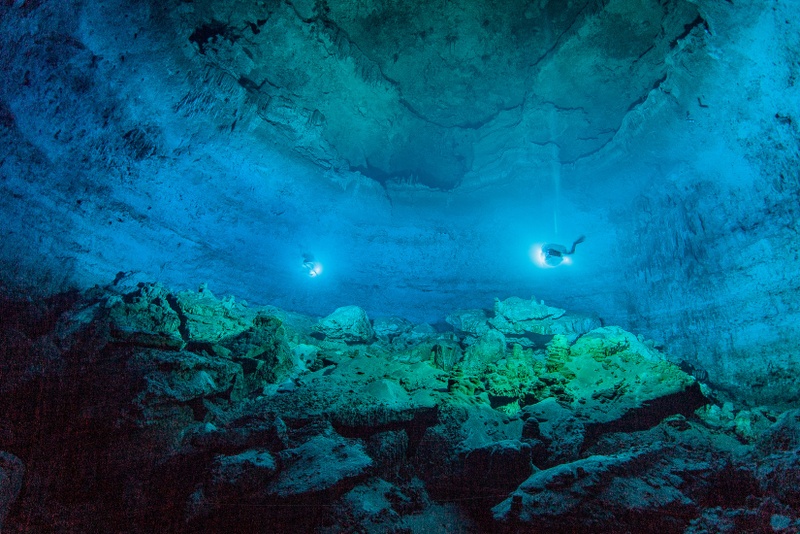 A broad view of Hoyo Negro, shot from the floor near the south edge, showing the immensity of the chamber and the complexity of the boulder-strewn bottom. One access tunnel can be seen near the ceiling at top left. This photo was taken by the “painting with light” method on a 30 second exposure. Text and photo credit: Roberto Chavez Arce
A broad view of Hoyo Negro, shot from the floor near the south edge, showing the immensity of the chamber and the complexity of the boulder-strewn bottom. One access tunnel can be seen near the ceiling at top left. This photo was taken by the “painting with light” method on a 30 second exposure. Text and photo credit: Roberto Chavez Arce
__________________________________
 The skull as it was discovered in 2007, resting against the left humerus (upper arm bone).
The skull as it was discovered in 2007, resting against the left humerus (upper arm bone).
Photo and text credit: Daniel Riordan Araujo
___________________________________
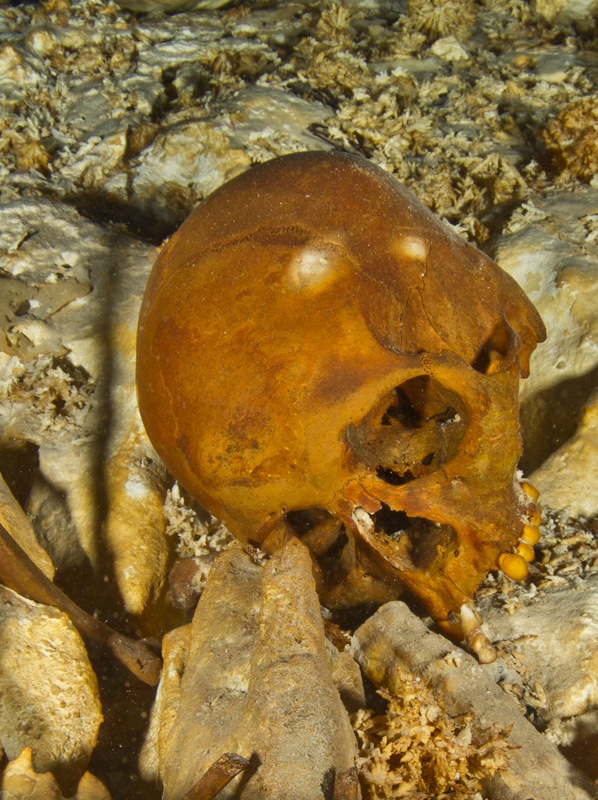 The skull as it appeared in December 2011, after rolling into a near-upright position.
The skull as it appeared in December 2011, after rolling into a near-upright position.
Photo credit: Roberto Chavez Arce
_____________________________________________
The Cave and The Water Nymph
Under the auspices of the new consortium, the task now fell to an international interdisciplinary team of scientist-specialists to undertake the meticulous job of additional recording, recovery, examination, and analysis of the various finds — finds that would eventually lead to some headline-making conclusions.
For the anthropologists and archaeologists of the group, the greatest excitement naturally focused on the human remains, what was turning out to be a nearly complete skeleton. But before anyone could understand the age and significance of the skeleton, they needed to understand the context. This required the efforts of specialists with knowledge of things like geology and cave formation, paleontology, dating techniques, and genetics.
Patricia Beddows of Northwestern University is one of those specialists. Her work has focused on cave systems formed by the dissolution of soluble carbonate rocks like limestone and dolomite, especially the flooded caves of the Yucatán Peninsula, including Hoyo Negro. She has logged countless hours diving into the cave systems. “Research in flooded caves is much like space exploration, with divers similar to astronauts reporting back to ‘mission control’ — a much larger scientific team at the surface,” said Beddows. “It all has to be done on SCUBA, which is our life support system.” Beddows’ studies have shown how the extensive Yucatán cave system has drained groundwater to the coast and how the water level in the caves has closely matched the sea level changes over time. “Using this knowledge, we understand how Hoyo Negro has changed over thousands of years,” she says. This has helped to date Hoyo Negro, once a drier cave chamber with lower water levels, to more than 12,000 years ago, when many of the bones or animals, including the human, had apparently fallen into or entered the cave. Her work with the re-crystalized rock sediments in the cave system also helped. The rocks and the bones in Hoyo Negro are coated with rock crystals, including a new form of crystal that Beddows calls “florets”. Using Uranium/Thorium dating analysis, scientists have been able to accurately and reliably date the bone. “An impressive aspect of this research is that we have dated the skeleton directly, but we also have supported these dates with additional dates on the florets,” Beddows said.
But narrowing down the dating has been very much a team effort, with a multi-pronged approach. To begin with, the cave-diving scientists knew that the human skeleton was found within the context of the skeletal remains of 26 large mammals, many of which were identified as the bones of long-extinct fauna, such as saber-toothed cats and gomphotheres (extinct relatives of mastodons). These are mammals that lived more than 11,000 years ago. The human skeleton was found near the bones of a gomphothere. Douglas Kennett, professor of environmental archaeology at Penn State, and Brendan J. Culleton, postdoctoral fellow in anthropology at Penn State, worked with colleagues to construct a geochronological framework for the skeleton by using a combination of methodologies that successfully constrained the age to the end of the Ice Age, the Late Pleistocene. Working with Yemane Asmerom and Victor Polyak from the University of New Mexico, they applied global sea level rise data to determine when the cave system filled with water. As the bones now lie about 130 feet below sea level, they estimated that sea level rise would have raised the groundwater level in the cave system and submerged the bones between 9,700 and 10,200 years ago. Thus, the latest animals and humans could have entered the cave system in a dry state was about 9,700 years ago.
In addition, enamel extracted from a tooth of the skeleton was radiocarbon dated to 12,900 years ago by Kennett’s lab.
“Unfortunately, we can’t rule out that the tooth enamel is contaminated with secondary carbonates from the cave system, but we removed potential contaminates using standard techniques and Tom Stafford, Stafford Research Laboratories, produced a comparable age,” said Kennett. “We consider this a maximum age and when combined with the uranium thorium dates from the adhering speleothems, we argue that the skeleton dates between 12,000 and 13,000 years ago. Well placed as a Paleoamerican.”
A Paleoamerican. This was something quite different than an ancient Mayan. The Maya, best known for the iconic monumental Mesoamerican cities like Chichen Itza, Tikal, and Copan, lived and dominated Central America from about 2000 B.C to about 1500 A.D. The Paleoamericans lived thousands of years earlier, inhabiting the American continents during the final glacial episodes of the late Pleistocene period, as far back as 15,000 years ago. The bones of this skeleton were dated to between 12,000 and 13,000 years ago. This represented one of the six oldest humans found in America. And it was certainly the most complete find for that time period.
But there was more to the skeleton than age. After examination, the team determined that the skeleton belonged to a slightly-built, 4-foot-10-inch girl of between 15 and 16 years of age. A teenager. She may have fallen into the pit while searching for water more than 12,000 years ago, the team surmised. A plausible scenario, as there was no evidence that she had been attacked, killed and dragged into the cave chamber by another preying animal. Scientific teams like to give nick-names to their biggest finds, especially if they are human skeletons. So the Hoyo Negro team called this one Naia, a greek reference to a water nymph. The name stuck and, along with names like “Lucy”, “Turkana Boy” and “Kennewick Man”, “Naia” was soon becoming something of a household word among scientists and the public, alike.
More important to the scientists, however, was that her features were consistent with those often attributed to Paleoamericans based on previous excavations and studies. “The earliest human skeletons found in the Americas differ markedly from those of modern Native Americans in the shapes of their skulls, faces and teeth,” said Dr. James C. Chatters of Applied Paleoscience, lead author of a recently published study related to the Hoyo Negro finds. The 9,000+-year-old Kennewick Man, found near Kennewick in Washington State in 1996, and also examined by Chatters, was a prime example.
Deciphering the ancestry of the first people to populate the Americas has been a challenge. On the basis of some genetic studies, modern Native Americans are thought to descend from Siberians who moved into eastern Beringia (the landmass that anciently connected Asia and North America) between 26,000 and 18,000 years ago. These people, considered the earliest Americans, are suggested to have then spread southward and populated the rest of the continent. But despite widespread support for this idea, the ancestry of the earliest Americans is still debated because, among other things, the facial features of the oldest American skeletons don’t look much like those of modern Native Americans. Thus, in terms of the Native American origins debate, the Hoyo Negro story is significant. And to this, the genetics contingent of the team had something to say about Naia………….
Haplogroups and Beringia
As is often the case, interdisciplinary scientific teams often turn to the best technical experts when it comes to finding answers to their questions. So it was that the Consortium approached Applied Paleoscience founder and Director James Chatters, a forensic anthropologist, archaeologist, and paleontologist. It was Chatters who played the lead role in the study of the famous Kennewick Man, and it is Chatters who is now leading the examination and analysis of Naia’s remains, resulting in a recently-published study that has catapulted Naia front-and-center on the stage of Native American origins research.
For the genetic examination component, Chatters recruited Brian Kemp of Washington State University to take the lead. Using the latest techniques, Kemp, a molecular anthropologist with expertise in the field of ancient human genetics, has sequenced DNA from ancient human remains found in both North and South America, including human coprolites — ancient excrement — from archaeological sites in Oregon and the American Southwest. His task was to tease out small amounts of Mitochodrial DNA (mtDNA), found in the energy-generating structures of cells, of one of Naia’s teeth. Isolating and sequencing mtDNA is common among studies of ancient human remains, as organisms contain many more copies of it than chromosomal DNA. And because it is inherited from the mother, one can determine maternal ancestry.
Extracting and analyzing Naia’s DNA was challenging, to say the least. “There is very little DNA preserved in a skeleton of such great antiquity,” said Kemp.
But because mtDNA is so much more plentiful than chromosomal DNA, and because scientists have now clocked years of experience sequencing mtDNA from ancient bones, it was a feasible undertaking. Using molecular biological techniques to amplify the DNA, Kemp was able to make hundreds of billions of copies of Naia’s original DNA material. “Once so many copies are made,” said Kemp, “it is pretty straightforward to study the DNA.”
The study results were enlightening. Kemp had determined that Naia shared a common ancestry with many of today’s Native Americans — a genetic signature that is derived from an Asian lineage but is only found in the Americas today. Called Haplogroup D1, it is found throughout North, Central and South America. It is thought that about 11% of Native Americans exhibit this haplogroup — especially in South America, where it shows up in about 29% of indigenous Chileans and Argentinians. Geneticists theorize that this lineage arose in Beringia after the ancient Beringian population separated from other Asian populations.
Kemp then asked two other expert colleagues to conduct similar tests on Naia’s tooth to verify his results. Deborah Bolnick, assistant professor of anthropology at the University of Texas at Austin, came up with essentially the same results. University of Illinois anthropology and Institute for Genomic Biology professor Ripan Malhi, focusing on regions of the mitogenome that mutate more slowly than other parts of the genome (and thus could be more reliable markers of genetic relatedness through time), also corroberated Kemp’s results.
Three separate labs had confirmed the same results. Naia, a Paleoamerican with physical characteristics distinctly different than today’s Native Americans, shared the same ancestry — an ancestry that pointed to ancient Beringia — and by extension to Asia.
The finding was not altogether startling. Previous studies have indicated similar results. But this is the first time that a nearly complete skeleton of this age has been genetically linked to today’s Native Americans, and protractively to Beringia and Asia. “Because she exhibits distinctive Paleoamerican skull and facial features,” says Bolnick, “the study shows for the first time that Paleoamericans with these distinctive features can have Beringia ancestry.”
Yet, what accounts for these different physical characteristics?
It could be evolution, suggests Bolnick and colleagues. “It seems likely that differences between Paleoamericans and Native Americans of today are due to evolutionary changes that occurred in Beringia and the Americas over the last 9,000 years,” she says. To support her suggestion, Bolnick points to evolutionary changes that have occurred over the last 10,000 years in other populations — a comparatively short time period on the evolutionary time scale, traditionally measured in millions of years. “There have also been studies of the skeletal morphology in later remains discovered in the Americas over the last 10,000 years. We certainly do see changes in the skull shape, in the facial features over that period of time.” She points additionally to Native American populations in South America who live at high altitudes, who evolved genetic and physical characteristics that have facilitated their survival in these regions.
____________________________________
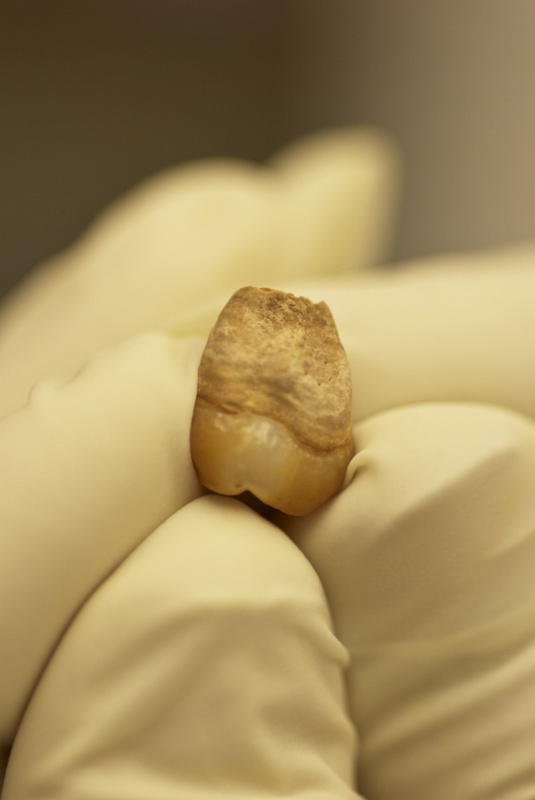 The upper right third molar of Naia, which was used for both radiocarbon dating and DNA extraction. The tooth is held by ancient genetics expert Brian Kemp of Washington State University, who led the genetic research on the skeleton. Photo credit: James Chatters
The upper right third molar of Naia, which was used for both radiocarbon dating and DNA extraction. The tooth is held by ancient genetics expert Brian Kemp of Washington State University, who led the genetic research on the skeleton. Photo credit: James Chatters
________________________________________________
The 10,000-Year Homeland
The Naia story and its evolutionary element have important implications in connection with other recent studies related to Native American origins. Some of them revolve around one emerging theory that has drawn the focus and attention of researchers from all over the world. Known as the “Beringia Standstill” theory, it was first suggested by two Latin American geneticists in 1997 and then refined or corroborated by a University of Tartu research team in Estonia in 2007. From a sampling of mitrochondrial DNA from more than 600 Native Americans, they found that mutations in the DNA pointed to the likelihood that a group of their direct ancestors from Siberia was isolated from their Siberian origins for at least several thousand years, during the time period from 25,000 (if not earlier) to 15,000 years ago (when ice-free corridors developed), before their descendants moved into the Americas. Evidence from recent paleo-ecological research suggested that this isolation most likely occurred in Beringia, a land mass that once covered the present-day Bering Strait between northeast Asia and Alaska.
“A number of supporting pieces have fallen in place during the last decade, including new evidence that central Beringia supported a shrub-tundra region with some trees during the last glacial maximum and was characterized by surprisingly mild temperatures, given the high latitude,” said John Hoffecker of CU-Boulder’s Institute of Arctic and Alpine Research, who is the lead author of a related Perspective article that appeared in the Feb. 28 issue of Science magazine.
This is an important aspect within the overall geographic context of the area, as the last glacial maximum reached its peak about 21,000 years ago with the development of massive ice sheets across North America and Europe, essentially blocking access to North America from northeast Asia until about 15,000 years ago. Thus the ice sheet barrier, along with distance from Siberia, would have created a geographic basis for the gap suggested by the genetic data.
But combining the genetics with the recent paleoecological research, which involved analyzing fossil pollen, plant and insect material taken from sample sediment cores from the now submerged landscape, has been the key.
“The genetic record has been very clear for several years that the Native American genome must have arisen in an isolated population at least by 25,000 years ago, and the bulk of the migrants to the Americas really didn’t arrive south of the ice sheets until nearly 15,000 years ago,” said co-author and University of Utah anthropologist Dennis O’Rourke. “The paleoecological data, which I think most geneticists have not been familiar with, indicate that Beringia was not a uniform environment, and there was a shrub-tundra region, or refugium, that likely provided habitats conducive to continuous human habitation.”
Scott Elias, an article co-author and a professor with the Department of Geography at Royal Holloway, elaborated: “We believe that these ancestors survived on the shrub tundra of the Bering Land Bridge because this was the only region of the Arctic where any woody plants were growing. They needed the wood for fuel to make camp fires in this bitterly cold region of the world. They would have used dwarf shrub wood to get a small fire going, then placed large mammal bones on top of the fire, to ignite the fats inside the bones. Once burning, large leg bones of ice-age mammals would have burned for hours, keeping people alive through Arctic winter nights.”
On the genetic side of things, the theory that humans inhabited Beringia for as much as 10,000 years “helps explain how a Native American genome (genetic blueprint) became separate from its Asian ancestor,” said O’Rourke.
“At some point, the genetic blueprint that defines Native American populations had to become distinct from that Asian ancestry,” he explains. “The only way to do that was for the population to be isolated. Most of us don’t believe that isolation took place in Siberia because we don’t see a place where a population could be sufficiently isolated. It would always have been in contact with other Asian groups on its periphery.”
“But if there were these shrub-tundra refugia in central Beringia, that [would have] provided a place where isolation could occur” due to distance from Siberia, O’Rourke says.
In contrast to the genetic and paleoenvironmental evidence, however, the archaeological record has been lacking. This would be explained by the suggestion that, according to a number of scholars, the archaeological evidence was submerged under the rising sea levels that resulted in today’s geography of the region. “These shrub-tundra areas were likely refugia for a population that would be invisible archaeologically, since the former Beringian lowlands are now submerged,” maintains O’Rourke. The suggestion that rising sea levels subsequently covered the evidence of human migration into the Americas has also been a long-standing theory among researchers studying the model that advances the notion that early Native Americans moved south along the Pacific coast as the glaciers receded and sea levels rose.
In addition, Hoffecker suggests that the Beringia inhabitants during the last glacial maximum could have made successful hunting forays into the uninhabited steppe-tundra region to both the east and west of central Beringia, where drier conditions and more grass supported a plentiful array of large grazing animals, including steppe bison, horse and mammoth.
There is now solid evidence for humans in Beringia before the last glacial maximum, as geneticists first predicted in 1997, according to Hoffecker. After the maximum, there are two sets of archaeological remains dating to less than 15,000 years ago. “One represents a late migration from Asia into Alaska at that time,” he said. “The other has no obvious source outside Beringia and may represent the people who are thought to have sheltered on the land bridge during the glacial maximum. If we are looking for a place to put all of these people during the last glacial maximum, Beringia may be the only realistic option.”
Hoffecker, O’Rourke and colleagues say new archaeological sites must be found in Beringia if the long human layover there is to be confirmed. Although most such sites are presumed to be underwater, they are hopeful that some evidence of human habitation in shrub-tundra areas might remain above sea level in low-lying portions of Alaska and eastern Chukotka (in Russia).
_____________________________________
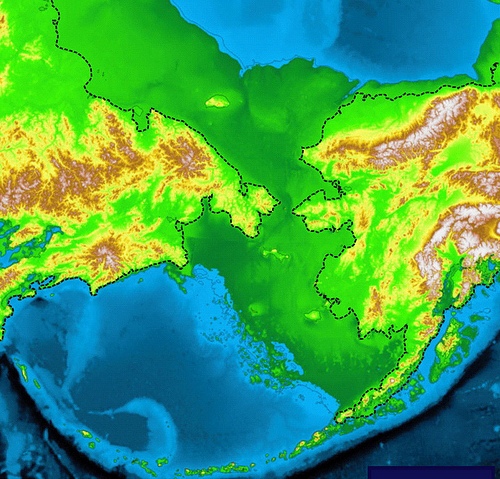 Map of ancient Beringia, showing the outlines of modern Siberia (left) and Alaska (right) with dashed lines. The area in dark green is the portion of Beringia (now submerged by the ocean) near the end of the last glacial maximum, a period that lasted from 28,000 to 18,000 years ago when sea levels were low and ice sheets extended south into what is now the northern part of the lower 48 states. Photo Credit: Wlliam Manley, Institute of Arctic and Alpine Research, University of Colorado. Illustration below: credit Julie McMahon
Map of ancient Beringia, showing the outlines of modern Siberia (left) and Alaska (right) with dashed lines. The area in dark green is the portion of Beringia (now submerged by the ocean) near the end of the last glacial maximum, a period that lasted from 28,000 to 18,000 years ago when sea levels were low and ice sheets extended south into what is now the northern part of the lower 48 states. Photo Credit: Wlliam Manley, Institute of Arctic and Alpine Research, University of Colorado. Illustration below: credit Julie McMahon
___________________________________________
 ___________________________________
___________________________________
Moving Forward
Although the Hoyo Negro findings have added significant additional support for the Beringian origins theory, the scientists caution that there is much more work to do before any far-reaching conclusions can be drawn. After all, Naia has shown that she is related to only 11 percent of all Native Americans. What about the other 89 percent? The findings thus far suggest that at least some modern-day Native Americans can trace their roots to an ancient Beringian population. But scientists have learned, over and over again, that the more they discover about human prehistory, the more they realize they don’t know. Reconstructing the past often turns out to be far more complicated than we initially suppose. And this, the Hoyo Negro scientists would likely agree, makes the whole journey of discovery all the more exciting.
“The dating and genetic analysis of Naia is a first step in what we hope will be a long productive investigation of Hoyo Negro,” says Chatters, looking ahead. “Our next steps will focus on attempting to sequence Naia’s nuclear DNA, determining the ages and genetics of the cave’s other animal skeletons and reconstructing the environment in which they and Naia lived.”
But it will all take a village of experts, just as it has to this point, employing a variety of disciplines and skills to re-create the evolving picture. “Balancing all of these elements has been a wonderful challenge,” says Pilar Luna from INAH. “On the one hand, we have a large team of renowned scientists who have been extremely generous sharing their knowledge and experience to analyze, understand, and interpret the findings, in order to produce the knowledge we have gotten so far. On the other hand, there are the cave divers, who have taken specialized courses to gather data for archaeological purposes, to properly record the general context taking samples, measurements, photos, videos, etc., and following with extreme care all requests made by the experts, in spite of the complexities and dangers of the cave itself. Also, we have had the support from engineers and technicians who have developed extraordinary methods to be used in this project for the first time, with significant results, mainly in the fields of software and photography.”
The combined efforts will extend to protecting the cave itself from would-be looters and other environmental dangers, so that research can continue as long as possible. “We feel obligated to protect this incredible resource,” says Nava. “So we are working with INAH and other Mexican authorities to control site access and make sure Hoyo Negro is preserved for future generations.”
Time will tell the ultimate fate of the Black Hole. In the meantime, what is collected of Naia’s remains will rest enshrined within laboratory walls and, perhaps in time, behind museum glass.
______________________________________________
Article Supplement
Naia’s World of Gomphotheres
When University of Arizona archaeologist Vance Holliday and colleagues began uncovering large fossilized bones at the site of El Fin del Mundo in the Sonoran Desert of northwestern Mexico in 2007, they weren’t sure what kind of animal they were unearthing.
“At first, just based on the size of the bone, we thought maybe it was a bison, because the extinct bison were a little bigger than our modern bison,” said Holliday, who has been researching geoarchaeology at Paleoindian sites across the U.S. for years.
Then, in 2008, they discovered something that clinched it for them.
“We finally found the mandible, and that’s what told the tale,” Holliday said.
It was a gomphothere.
Actually, two of them.
About the same size as a modern elephant, but smaller than their extinct cousins the mammoths, gomphotheres were once widespread in North America but were thought to have disappeared from the fossil record long before humans arrived in North America some 13,000 to 13,500 years ago.
Until now.
Radiocarbon dating of charcoal flecks and burned bone found within the context of the fossils indicated a reliable age of 13,390 years. This made these two gomphotheres the last known gomphotheres in North America.
________________________________
Gomphothere mandible in place, upside down, at El Fin del Mundo excavation site. The fossil was fully prepared at the INAH zooarchaeology lab in Mexico City. Image courtesy of Vance T. Holliday.
______________________________
The fully excavated and prepared gomphothere mandible. Courtesy Joaquin Arroyo-Cabrales/Instituto Nacional de Antropología e Historia
_____________________________
These sculptures, made by Mexican artist Sergio de la Rosa, show three elephant ancestors: (from left to right) the mastodon, the mammoth and the gomphothere. Courtesy Sergio de la Rosa
_______________________________
But there was more.
As they excavated among the bones, they also uncovered human artifacts—Clovis artifacts, to be specific—including 7 projectile points, some stone cutting tools and 21 flint flakes from stone tool-making. The position and proximity of the Clovis fragments relative to the gomphothere bones at the site suggested that humans did in fact kill the two animals there. Of the seven points found at the site, four were in place among the bones, including one with bone and teeth fragments above and below. The other three points had eroded away from the bone bed and were found scattered nearby. This suggested that the gomphotheres were likely hunted and thus constituted a Clovis prey species, along with mammoths, mastodons, and bison, already known to have been hunted by the Clovis.
________________________________
A clear quartz Clovis point found near the bone bed at El Fin del Mundo. Although very difficult to shape into a tool, quartz was used by Clovis tool makers at several sites. Courtesy INAH Sonora.
______________________________
“This is the first Clovis gomphothere, it’s the first archaeological gomphothere found in North America, it’s the first evidence that people were hunting gomphotheres in North America, and it adds another item to the Clovis menu,” Holliday said.
The Clovis culture, today considered the oldest clearly defined and recognized Paleoindian culture in the Americas, is characterized by its distinctive stone tools, particularly the fluted projectile points. The first examples of this culture were discovered by archaeologists near Clovis, New Mexico, in the 1930s. The El Fin del Mundo site, along with the Aubrey site in Texas, is now among two sites that show the earliest solid evidence of Clovis hunting in North America, indicating that the earliest widespread and recognizable group of hunter-gatherers were already in place 13,390 years ago in the North American Southwest.
Holliday and colleagues suggest that the finds support the model of an American southwestern origin for the Clovis material culture. As they conclude in the study, published this week in the Proceedings of the National Academy of Sciences:
“These data expand our understanding of the age range for Clovis, Clovis diet, raw material preference, and the late Pleistocene megafaunal assemblage of North America, and provide evidence for a southern origin of the Clovis technocomplex.”*
Holliday and the study team report that the radiocarbon ages from El Fin del Mundo were made based on testing the site’s charcoal, shell, and organic matter at the Arizona Accelerator Mass Spectrometry Laboratory.
_______________________________
*Article #14-04546: “Human (Clovis)–gomphothere (Cuvieronius sp.) association ~13,390 calibrated yBP in Sonora, Mexico,” by Vance T. Holliday et al.
In addition to Holliday, authors of the PNAS paper include: lead author Guadalupe Sanchez, who has a doctorate in anthropology from the UA; UA alumni Edmund P. Gaines and Susan M. Mentzer; UA doctoral candidates Natalia Martínez-Tagüeña and Andrew Kowler; UA master’s student Ismael Sanchez-Morales; UA scientists Todd Lange and Gregory Hodgins; and Joaquin Arroyo-Cabrales at the Instituto Nacional de Antropología e Historia.
The dig at El Fin del Mundo, a joint effort between the U.S. and Mexico, was funded by the UA School of Anthropology’s Argonaut Archaeological Research Fund, the National Geographic Society, the Instituto Nacional de Antropología e Historia and The Center for Desert Archaeology in Tucson.
Source: Some material for this article was adapted and edited from a University of Arizona press release, Meet the gomphothere: UA archaeologist involved in discovery of bones of elephant ancestor
________________________________________
Spirit Cave
By Jesse Holth
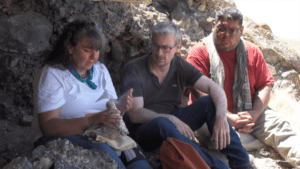
_______________________________
In 1940, archaeologists Georgia and Sydney Wheeler were working for the Nevada State Parks Commission, surveying for sites that were damaged by looting and guano mining. The couple, performing salvage excavations in the Great Basin Desert, noticed a cave and discovered a short passage inside, leading to a small chamber. Creating a test pit along the chamber’s back wall, Georgia uncovered two sets of human remains, stacked on top of each other. The first burial was one foot deep, wrapped with a fragment of finely woven (twined) tule or cat-tail. Beneath it, she found the second burial at a depth of 2.3 feet.
Working on Burial 2, the Wheelers noted in their journal: “Upper portion of body is partially mummified. Leather mocassins [sic] on the feet. Scalp and some hair on the head. The hair was black when uncovered but rapidly changed to reddish on exposure to the light and air. Body was laid on a fur blanket. Finely woven twined mat of tule or cat-tail was wrapped around upper portion and stitched to form a bag over the head. A second similar mat was wrapped around the lower portion. The mats overlapped. An open twined mat was placed over the whole bundle and the lower corners tied together under the feet.”
It was a remarkable find.
The Wheelers named the site Spirit Cave, and the second, better preserved burial became known as the “Spirit Cave Mummy”. That summer, the remains were displayed at the Nevada State Fair in Fallon before being moved to the Nevada State Museum, where they remained for fifty years. It wasn’t until the 1990s that the significance of this find would be revealed: originally thought to be only 1,500–2,000 years old, radiocarbon testing between 1994 and 1996 dated the remains to 10,500 years old. The Wheelers had discovered remains that were preserved less than a meter below the surface for a shocking ten millennia.
The 1990s also saw the introduction of new legislation regarding ancient remains: NAGPRA, the Native American Graves Protection and Repatriation Act. The Fallon Paiute-Shoshone Tribe made a NAGPRA claim in 1997, stating cultural affiliation with the remains from Spirit Cave. But it wasn’t until recently that DNA evidence proved this affiliation – long after requests to repatriate the remains were refused, mainly based on morphometric analysis of the cranium. This type of identification has since been debated, especially when it comes to NAGPRA claims. DNA analysis is much more accurate, rapidly becoming the ‘gold standard’ for assessing relationships between individuals and populations.
Studies from 1997 indicated that the Spirit Cave Mummy was a male between the ages of 40 and 50, with traces of osteoarthritis in his joints and an extra thoracic vertebra (13 rather than 12). There was a fracture to the frontal bone of his skull, which had completely healed, but three abscessed teeth which were likely the cause of death. His last meals were bulrush (Scirpus) seeds, and two species of fish, likely from the marshes near the cave.
Peopling the Americas: An Emerging New Picture
Although the Spirit Cave remains have been rightfully repatriated, this has not stopped the advancement of scientific inquiry. New research, conducted by Professor Eske Willerslev and colleagues, provides insight into the genetics of not only Spirit Cave, but other remains across North and South America. This includes the 10,400-year-old Lagoa Santa remains, found in Brazil in the 19th century. Together, DNA findings from these two sites contradict the earlier belief that they had belonged to a group of “Paleoamericans” pre-dating Native Americans. “Our study proves that Spirit Cave and Lagoa Santa were actually genetically closer to contemporary Native Americans than to any other ancient or contemporary group sequenced to date,” said Willerslev, who holds positions at both St. John’s College, University of Cambridge, and the University of Copenhagen.
The study involved sequencing 15 genomes from ancient specimens, six of which are over 10,000 years old, and spanned a geographic range from Alaska to Patagonia. Interestingly, all of the remains studied were most closely related to Native Americans, including two so-called “Paleoamericans” and an individual from Ancient Beringia. This challenges a previous theory that “Paleoamericans” were distinct from Native Americans because they had a different cranial form. Craniometry is a centuries-old method that increasingly seems to have very little bearing on modern archaeology and genetic identity. As Willerslev stated, “Looking at the bumps and shapes of a head does not help you understand the true genetic ancestry of a population.”
Specifically, research was conducted on the remains of four individuals from Lovelock Cave, Nevada; five individuals from Lagoa Santa, Brazil; an Incan mummy from Mendoza, Argentina; one individual each from Punta Santa Ana and Ayayema in Patagonian Chile; and remains from Trail Creek Cave 2 (Alaska), Big Bar Lake (British Columbia), and Spirit Cave (Nevada). Based on the DNA sequencing, researchers suggested an unsampled outgroup may have split from Native Americans around 24,700 years ago, overlapping with the inferred split of Native Americans from Siberians and East Asians at 26,100–23,900 years ago. While more data is required, this means that multiple splits occurred in Beringia within a short span of time, which could imply that a moderate population structure existed within Beringia. This supports a “Beringian standstill hypothesis”, as demonstrated by sites like Bluefish Caves.
The researchers estimated, based on their models of divergence, that the dispersal process in the Americas was considerably rapid – with populations expanding across North America in as little as centuries, and into eastern South America within a millennium or two. Data from Spirit Cave and Lagoa Santa showed that the dispersal pattern south of the continental ice sheets involved complex admixture events between earlier established populations. This is suggestive of multiple dispersals into South America. Moreover, the presence of the Australasian genomic signature in Brazil (at Lagoa Santa) indicates a population that reached South America but left no apparent traces in North America. Previous evidence for coastal dispersals could mean that the Australasian signal was brought to South America by a distinct seafaring population.
Geographic barriers like mountains often affect genetic signals, and the study revealed distinct ancestry in populations east of the Andes versus those on the western side. Isolation of gene pools can occur, causing a divergence in genetic signals. The study indicated that soon after arrival, South Americans diverged along multiple geographic paths, and that a second independent migration and gene flow occurred in the Middle to Late Holocene. Researchers also provided further evidence of isolation between groups of different populations in coastal British Columbia versus interior British Columbia (see “The Canadian Iceman”).
The Spirit Cave genome has strong genetic affinities to Lagoa Santa, but the Australasian signal was only detected in one of the Lagoa Santa individuals – the rest of these “Paleoamericans” had no Australasian signal. The Paleoamerican cranial form, therefore, is not associated with the Australasian genetic signal as previously suggested. This study demonstrated that divergences can be principally cultural, and that archaeological, anatomical, and genetic records are not necessary congruent. For example, Spirit Cave was originally thought to represent a genetically divergent group from Clovis, simply because the technologies found were different – but genetically close populations, in this case living on either side of the Rockies, can develop different cultural adaptations.
____________________________
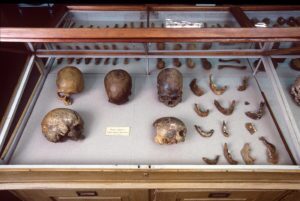
Skulls and other human remains from P.W. Lund’s Collection from Lagoa Santa, Brazil. Kept in the Natural History Museum of Denmark. Natural History Museum of Denmark
____________________________

A skull from P.W. Lund’s Collection from Lagoa Santa, Brazil. Kept in the Natural History Museum of Denmark. Natural History Museum of Denmark
____________________________
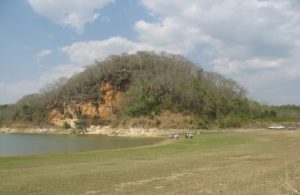
Sumidouro Lake in Lagoa Santa, Brazil. The formation to the right of the picture contains the caves where the skulls were found. Natural History Museum of Denmark
____________________________
Diversity and Cultural Respect
Human dispersal and divergence in the Americas is still full of unanswered questions. Archaeologists are constantly discovering older sites and remains, pushing our dates back even further, and genetic discoveries are consistently complicating our view of the past. This study of Spirit Cave and other DNA sequences provided evidence that movement in the Americas was not simple, and not gradual – it entailed many different population groups, some still unknown, essentially “leap-frogging” across large landscapes. Some of these groups filled new environmental niches, and genetically drifted from ancestor populations due to isolation and geographic barriers.
It is important to remember, as we keep looking for answers, that there are still living descendants of some of these groups. NAGPRA provides some recourse for Native Americans looking for repatriation, but often it requires DNA evidence to demonstrate cultural affiliation. In the case of Spirit Cave, Professor Willerslev assured the Fallon Paiute-Shoshone Tribe that he “would not do the DNA testing unless they gave permission.” Once the remains were proven to belong to an ancestor, they were returned to the tribe and Willerslev attended the private reburial ceremony. He said, “it would be like if our father or mother was put in an exhibition,” noting that it was “deeply emotional and deeply cultural.” The tribe was involved throughout the process, and two members were present when all of the DNA sampling was done. Science and cultural sensitivity need not be at odds, as some have suggested: Spirit Cave and the Canadian Iceman are examples of how to be respectful as archaeologists, and that the overarching mandate should be to listen to living peoples about their ancestors.
_________________________________

Professor Eske Willerslev with Donna and Joey, two members of the Fallon Paiute-Shoshone tribe. Linus Mørk, Magus Film
_________________________________


